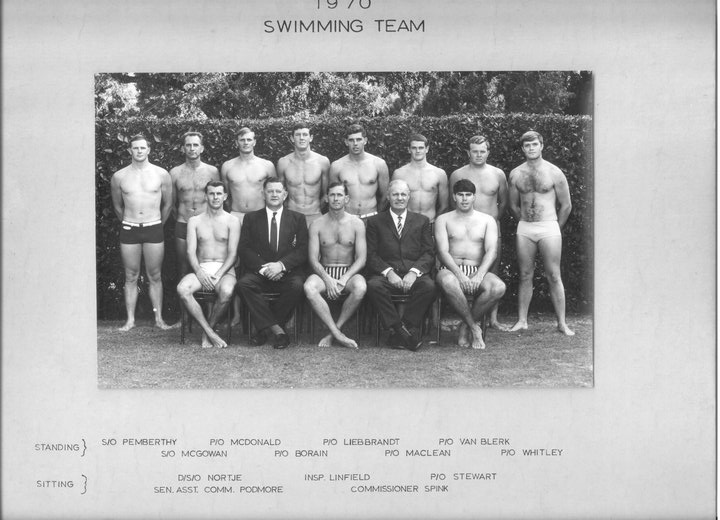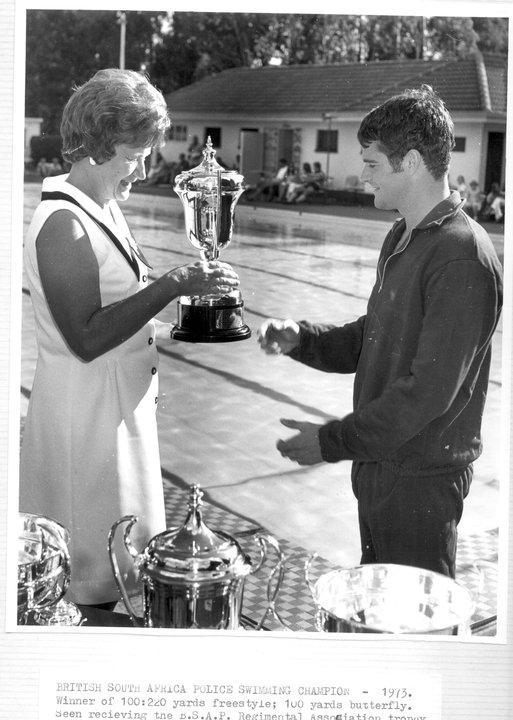Swimming
- Hits: 8304
The sport developed in the United States in the 1930s. The sport’s governing body replaced the name synchronized swimming with artistic swimming in 2017. FINA first recognized synchronized swimming in 1954. Swimmers in solo, duet, or team (four to eight persons) competition.
Together with swimming, diving and water polo, synchronized swimming became the fourth sporting code to participate in the annual aquatic championships organized by the national governing body, then known as the South African Amateur Swimming Union (SAASU).
In 1972 South Africa was one of 14 countries that held a national Championships for synchronised swimming.
Until the 1992 Olympic Games when South Africans were again allowed to compete in international sports, South African synchronised swimmers were mostly limited to annual competitions against their Rhodesian neighbours between 1974 and 1980. Five swimmers were awarded Springbok colours in 1974, including sisters Colleen and Wendy Davies and Beverley and Aileen Martin, and also Karen Edmunds.
The Davies sisters again swam for South Africa against Rhodesia in 1975, with Lyle Walsh, Sandra Clokie and Jane Hart. In 1976 Tanya Mansfield was selected with Sandra Clokie, Lyle Walsh, Jane Hart and Colleen Davies. In 1977 no synchro team seems to have been selected for the Tests against Rhodesia. In 1978 Clokie, Mansfield and Hart were joined by Allison Gittings and Allison Blackbeard - a sister of international superstar swimmer Paul Blackbeard. In 1979 Sandra Clokie, Allison Blackbeard and Allison Gittings joined Kerry Woodhead and Susan Scott for the annual showdown against the Rhodesians. The same five swimmers were selected for the last Test against Rhodesia held in Cape Town in 1980.
Amanda Taylor and Lauren Wulhsohn were selected to compete at the 1992 Olympic Games. In 2021 Clarissa Johnston and Laura Stugnell swam at the Tokyo Olympic Games.
Clarissa Johnston and Laura Strugnell from South Africa were equally excited. The two were simply happy to even be there and to finally showcase their routines. They barely held back tears after scoring above 70 in both of their routines, which was their main goal at these Olympics. Since the 2019 World Championships, the country has improved by 5.4 points in tech and 4.8 in free.
In 1994 Renáta Pešlová competed at the Commonwealth Games and the FINA World Championships.
Nine swimmers went to the 7th FINA World Championships held in Italy in 1994, and 8 went to the next FINA Championships in 1998.
Judie-Ann van Niekerk was the only synchro swimmer to compete in the 9th FINA Championships held in Japan in 2001, and the 2002 Commonwealth Games in Manchester.
After 1992 the various sporting codes started to organize their own annual championships after the traditional provincial system has been disbanded to be replaced by a club-based one, managed by Swimming South Africa. Currently, the sport competes at Novice, 12&Under, Youth and Junior Solo champions and the Novice, Youth and Senior Duet champions across both SA National Age Group and SA Nationals. Some male athletes and mixed duet are competing at SA Nationals level.
In Cape Town the Baracuda SC is run by Sue and Emma Manners-Wood - click here to see their website.
The Aquanova SC is based in East London. In Port Elizabeth Moira Norden now manages the Aquabear SC synchro division. Kingfisher AquaSync Artistic Swimming Club is based in Pretoria, while Team Phoenix is a Johannesburg club. .
Other clubs include the Umlazi Sharks Aquactic Club in Durban, and Cosmo Dolphins in Roodepoort. Some schools also have synchro as a school sport. These include Collegiate in Port Elizabeth, Wynberg in Cape Town and Kingsmead in Johannesburg.
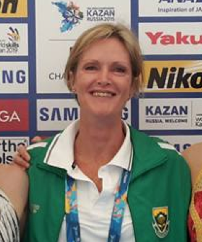
coach Sue Manners-Wood
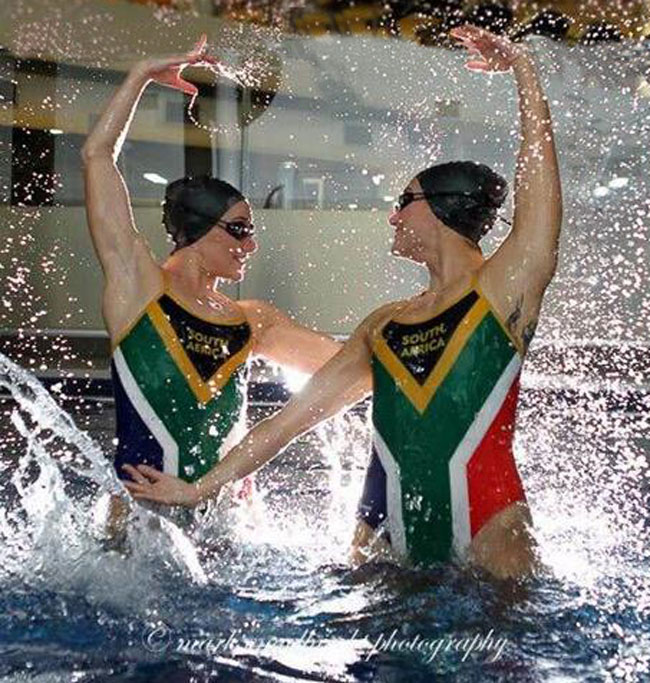
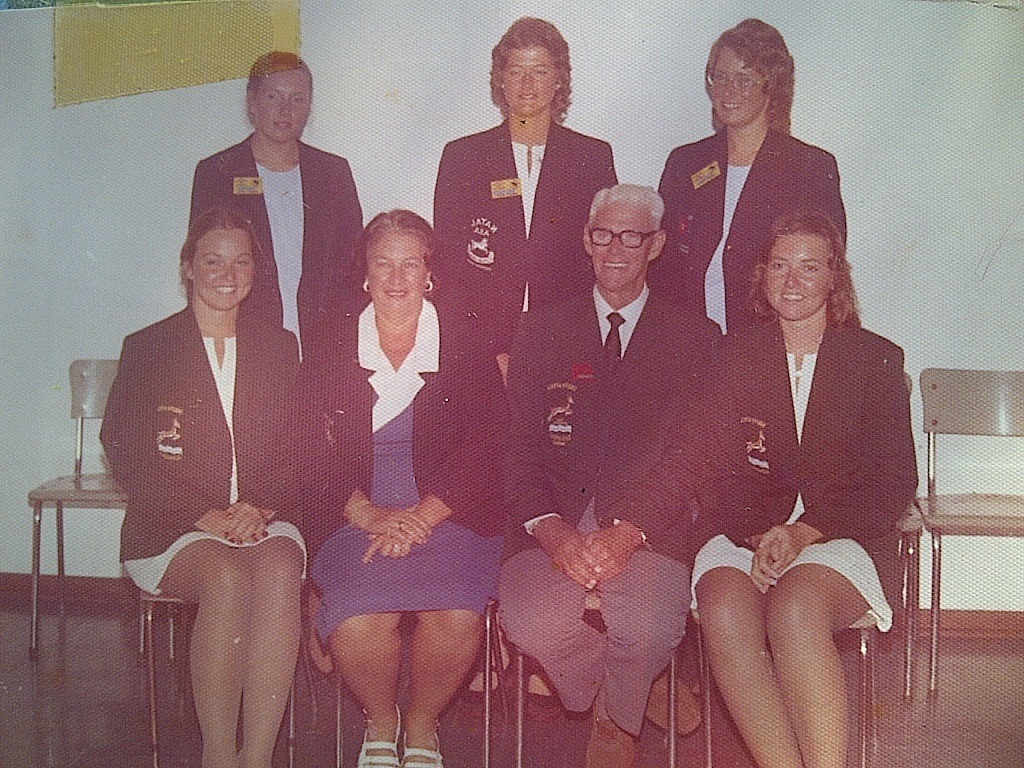
1975 Springbok Synchronised Swimming Team with manager Vic Myburgh and coach Dot Schoombie.
Synchronised Swimming is a comparatively new sport in South Africa, but has been swum competitively in other countries since 1945. Basically, Synchronised Swimming is the performance of aquatic movement by one or more performers, synchronised to a musical accompaniment and each other. Many people argue as to whether Synchronised Swimming is an art or a skill. It is a skilful art, requiring a good sense of balance, rhythm, endurance and physical fitness. Synchronised Swimming can be divided into two parts — Stunts and Routines, and mastery of both is essential for the good Synchro girl.
A Synchro swimmer's life revolves around the Stunts, which are all laid down in the F.I.N.A. Handbook, as until these can be mastered, progression to routines is both useless and undesirable. When it is fully understood that the marks earned in the Stunt competition or championship are carried to all routines performed, it will be appreciated why the correct performance of stunts is so important. The term "Stunts", may be a misnomer, giving the uninitiated the idea of a circus performer. A more suitable term would probably be Aqua Gymnas- tics, or even Aquabatics. To perform stunts, swimmers must have above average muscle control, the ability to gauge distance and direction under-water with eyes open while the body is performing intricate and difficult movements, tremendous breath control (some stunts can take up to 17 seconds under water when performed by a skilled synchro girl), and the strength of arms to support the weight of the body.
To anyone who suffers claustrophobia when submerged, Synchro would be impossible. Constant exercise of the correct muscles is necessary during the winter months, both to keep the body supple and strengthen the muscles, and special exercises have been devised to meet the needs of Synchronised Swimmers. After an off-season break, it is necessary for a Synchro swimmer to build up stamina in the water by daily training, which comprises swimming of all strokes, and sculling. For the top performer, a minimum of 1,000 yards a day is necessary, until stamina has been resumed, when an hour of stunt practice daily is necessary.
These stunts are highly technical in detail, and deficiencies are not always noticeable to the untutored eye. Infinite patience is needed by coach and competitor, if all phases of the stunts are to be done correctly, and together with Judges, a high degree of knowledge of the basic positions is essential to all. Routines are a completely different type of challenge. A Synchro girl can have tremendous skill in stunts, and be completely unable to swim a routine with grace and in time to music. The reverse can also apply, of course, and it is to blend these two different skills into a perfect whole, that is the airy of every coach and swimmer.
The full report (below) is from the 1973 SAASU Annual Report.
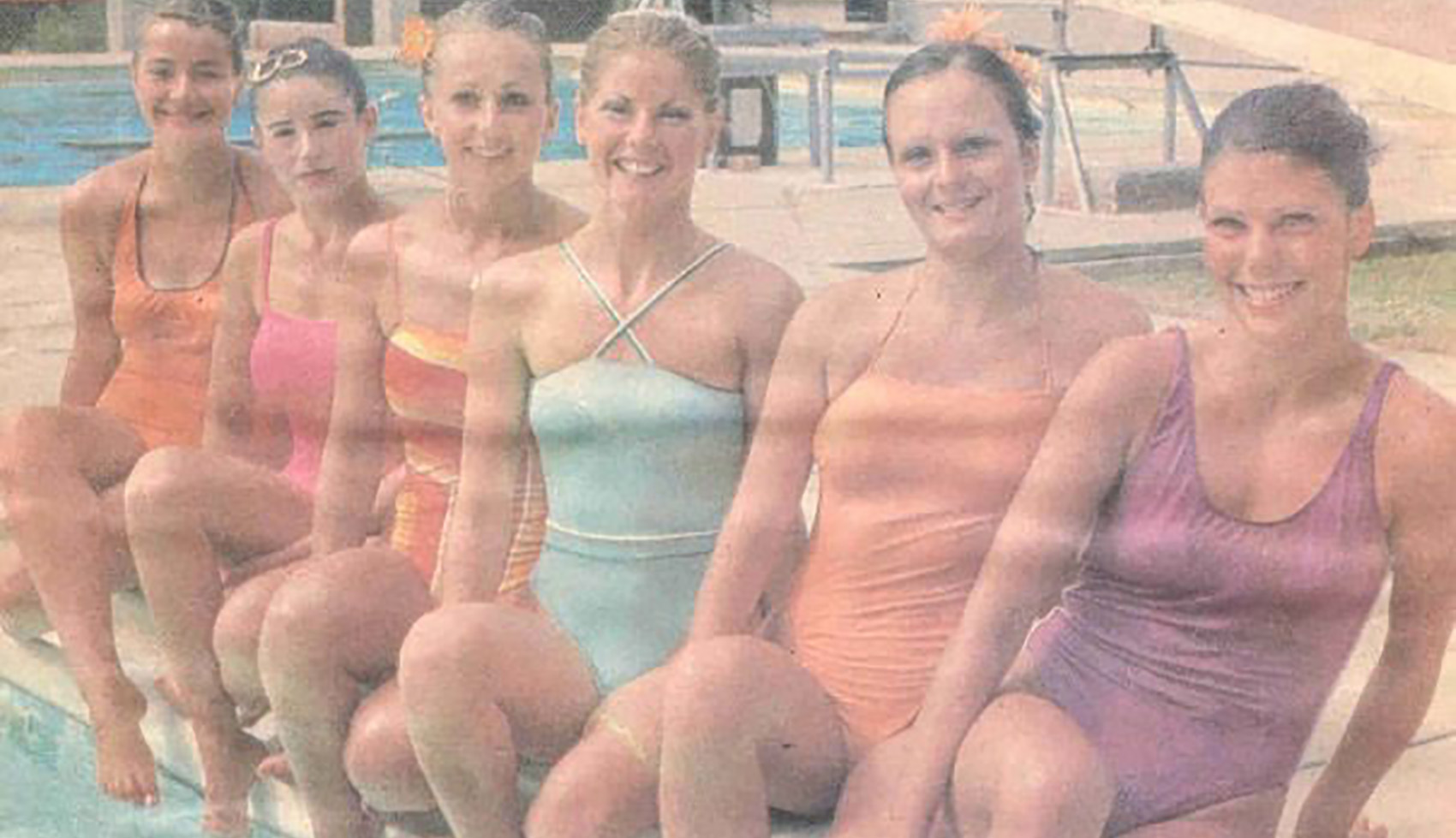
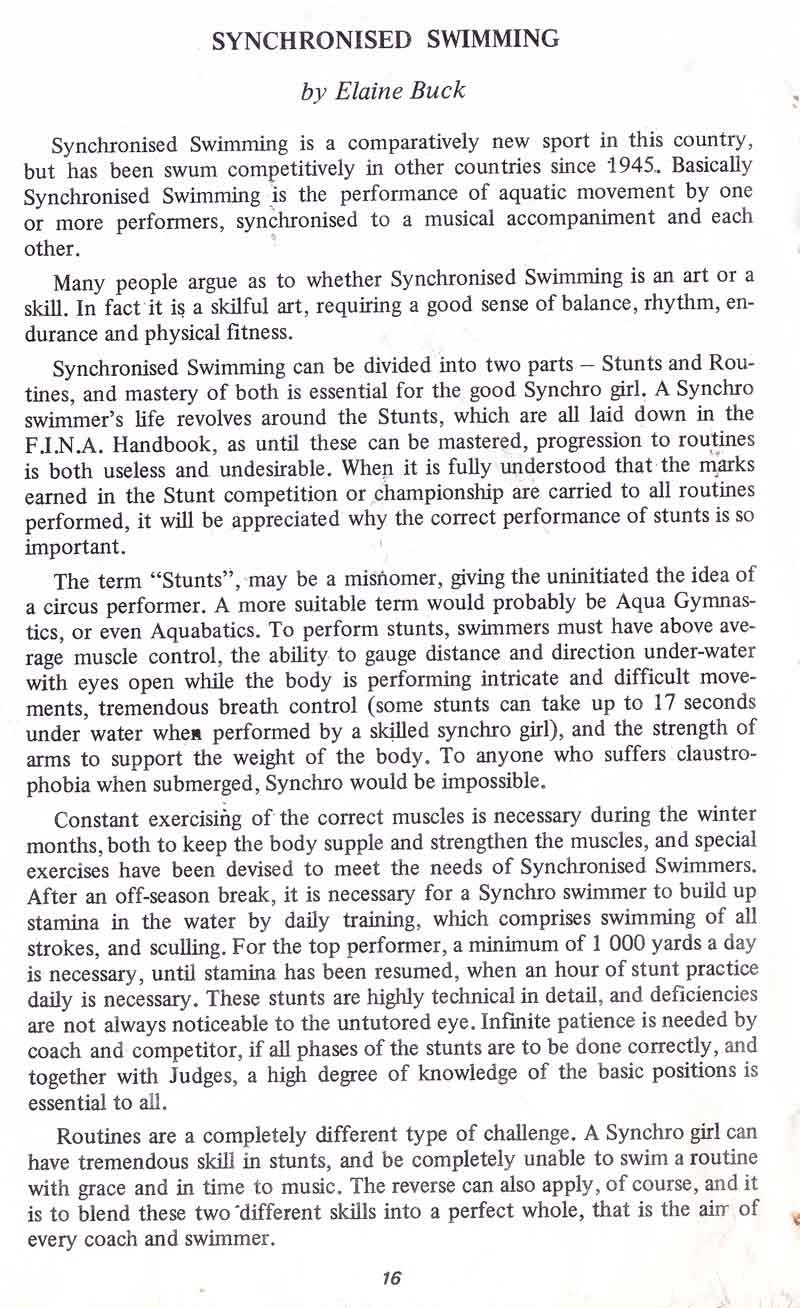
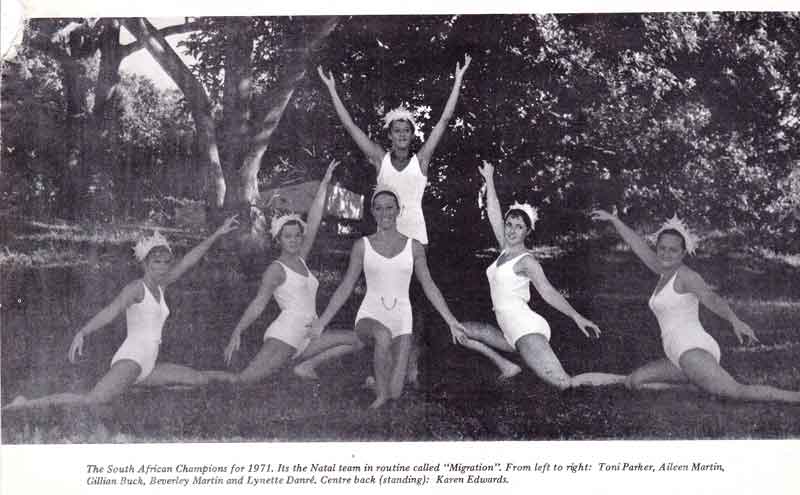
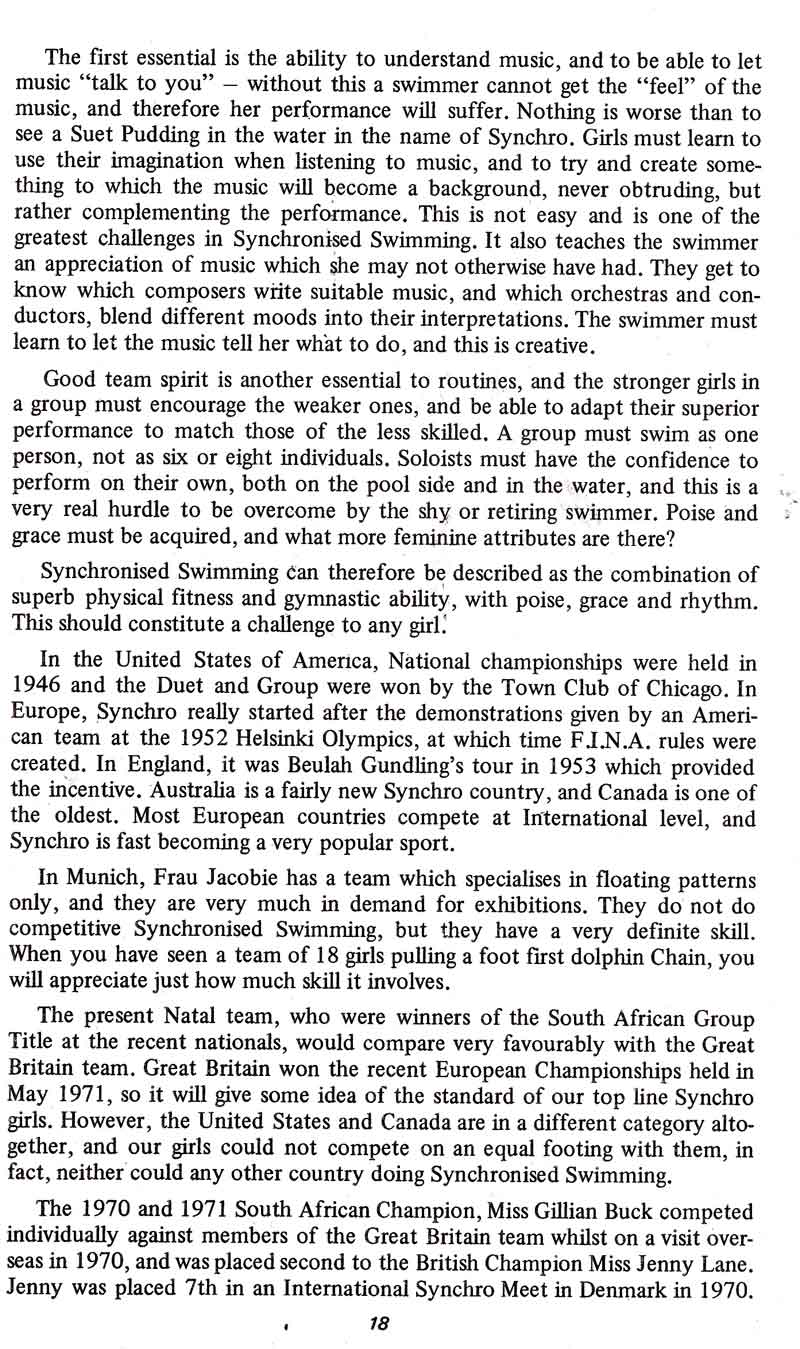
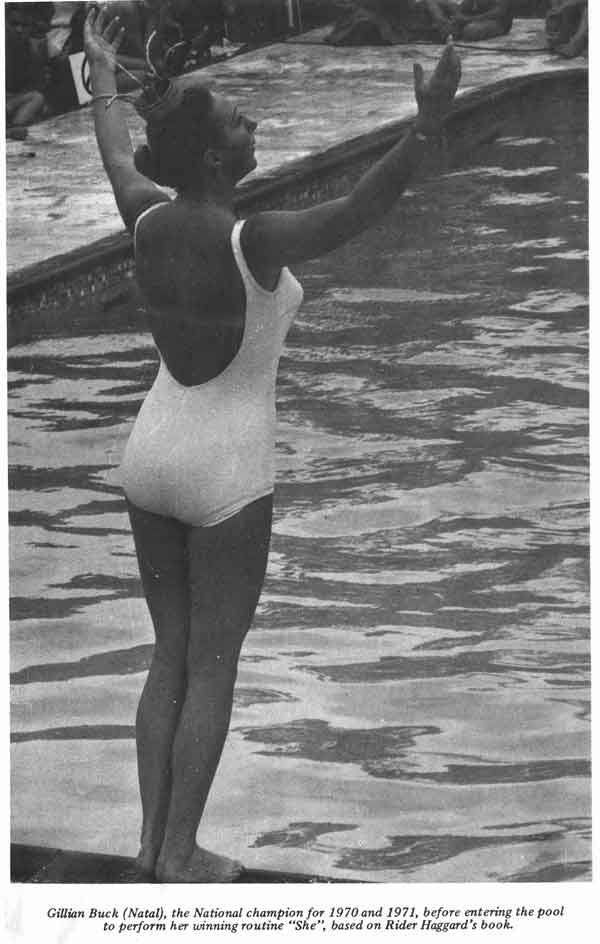
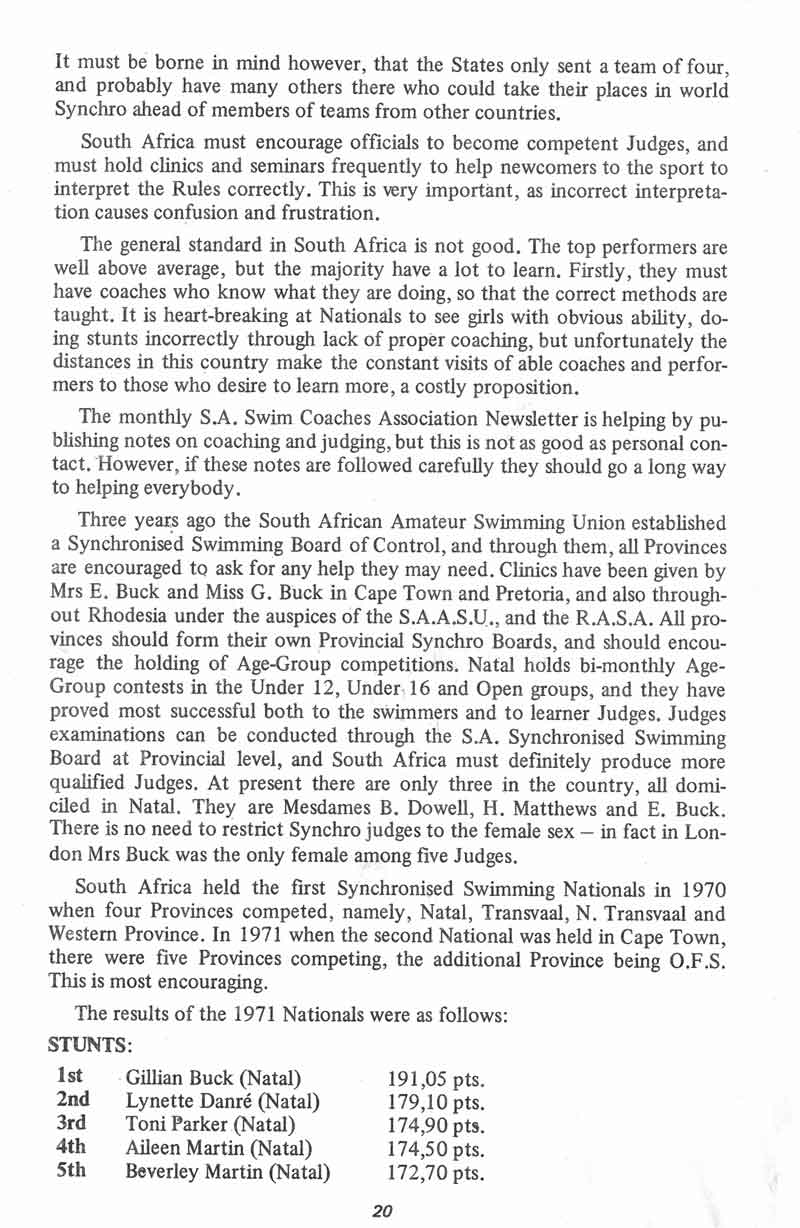
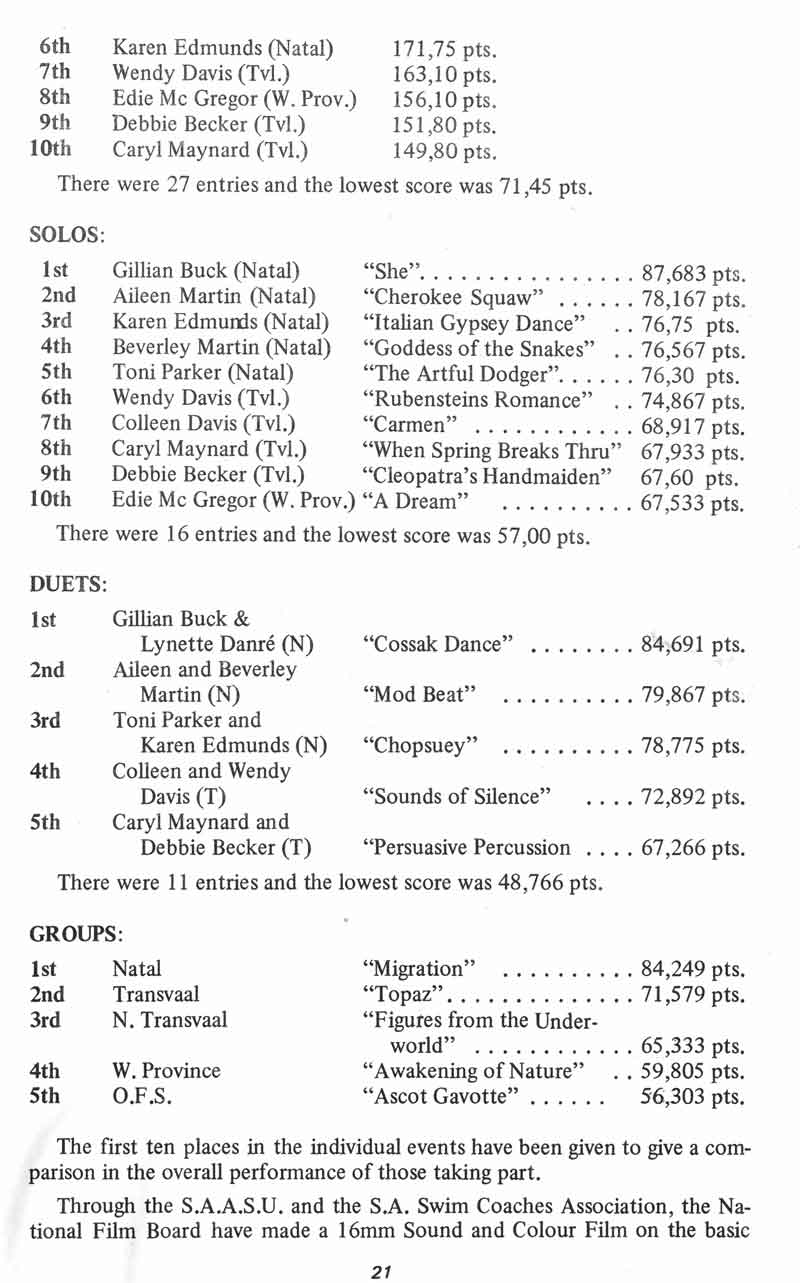
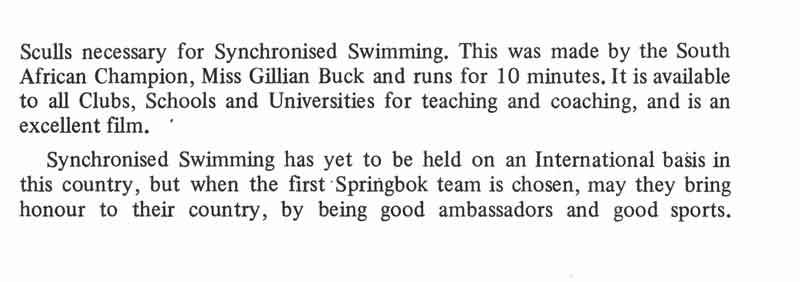
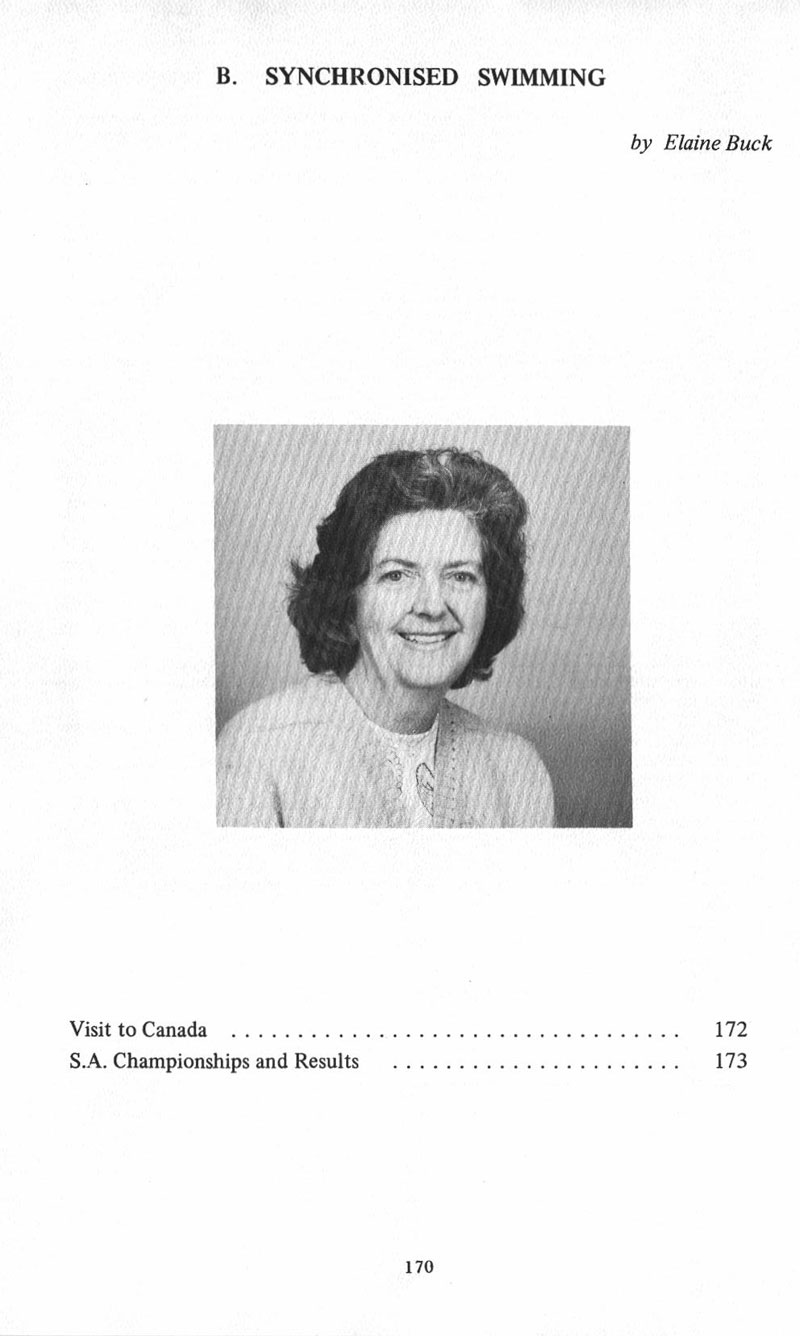
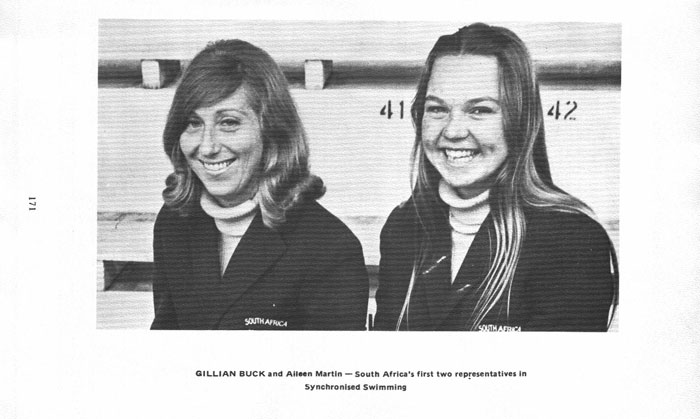
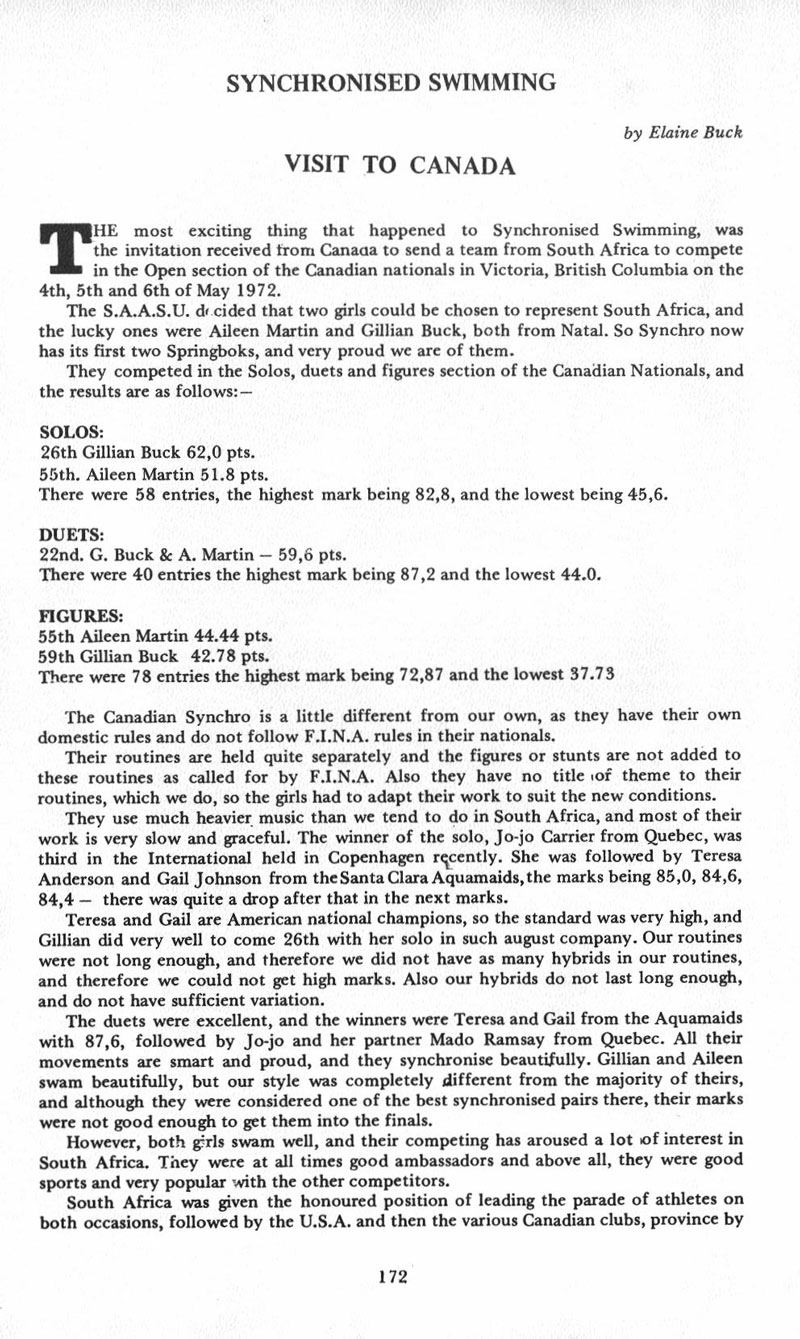
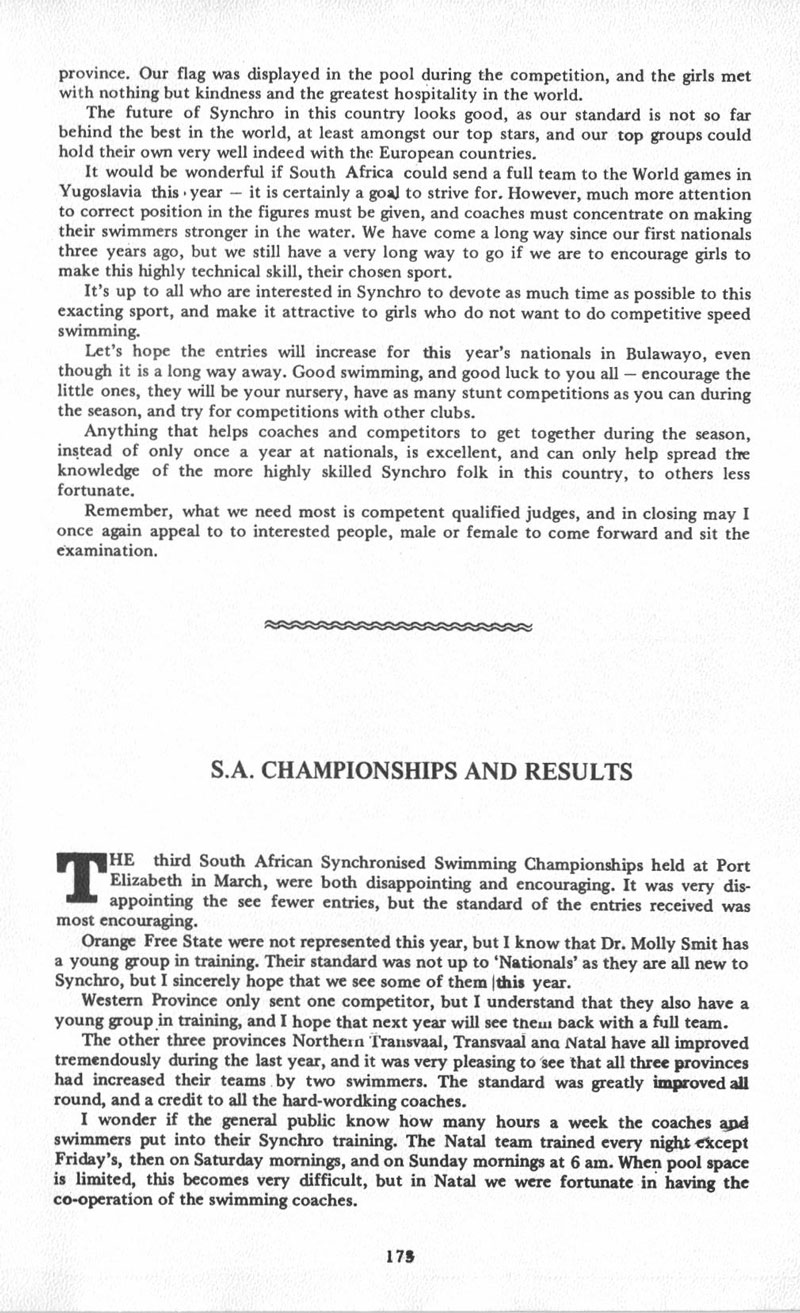
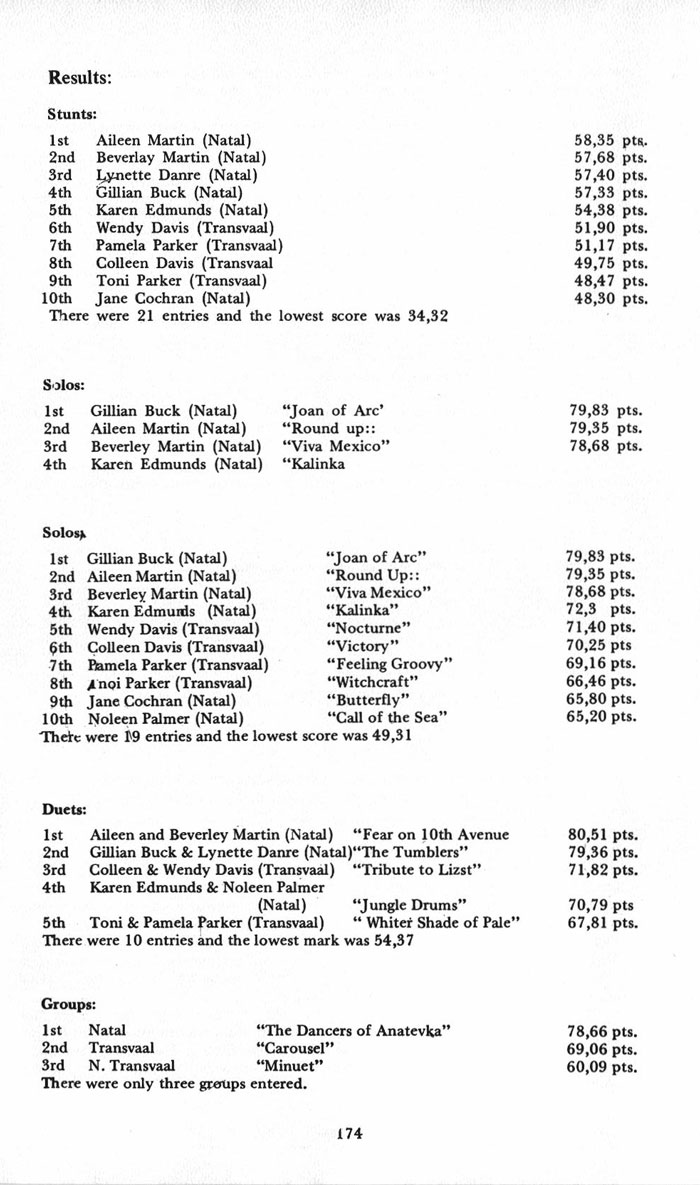
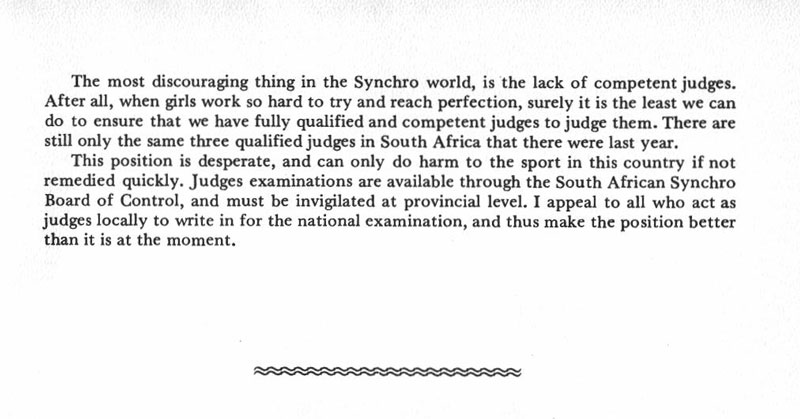
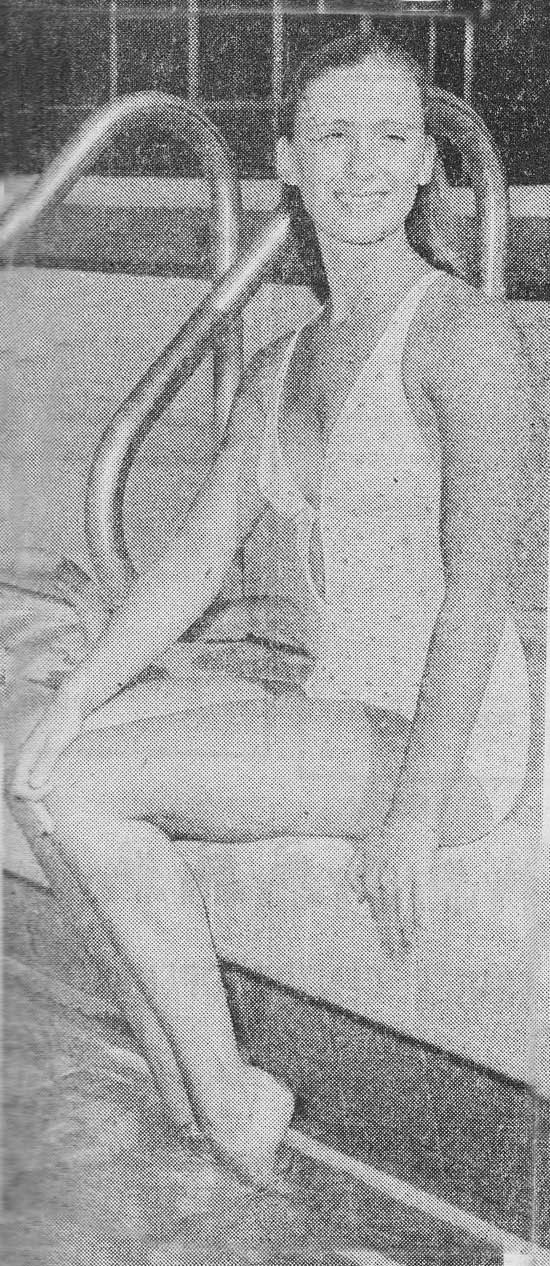

Amanda Norrish was an American world champion (1973 and 1975) synchronised swimmer who visited and lived in South Africa for a period in 1976-1977. She gave coaching clinics in South Africa and Rhodesia.
Other coaches who visited the country at that time included Marion Kane and Laurie Miller of the USA, Donalda Smith of Canada and Dawn Zajac of Great Britain.
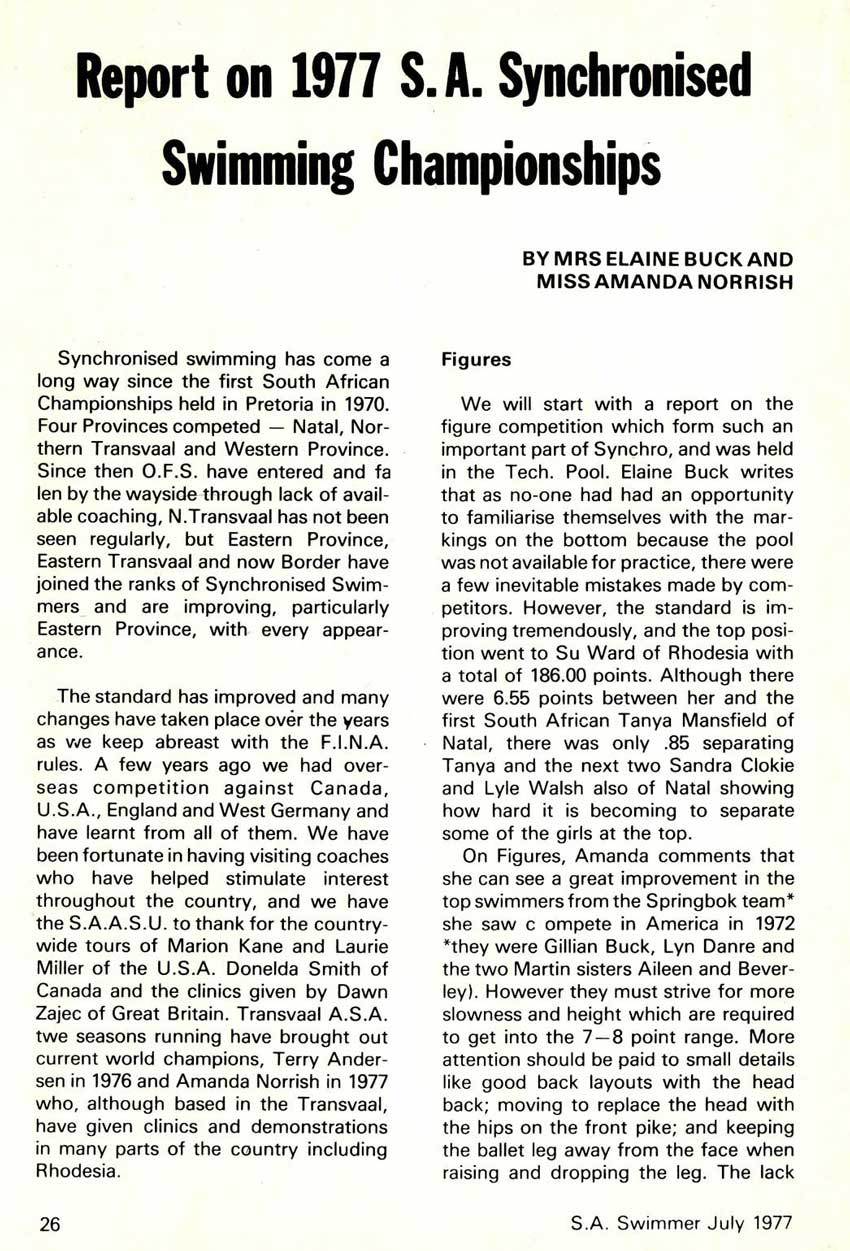
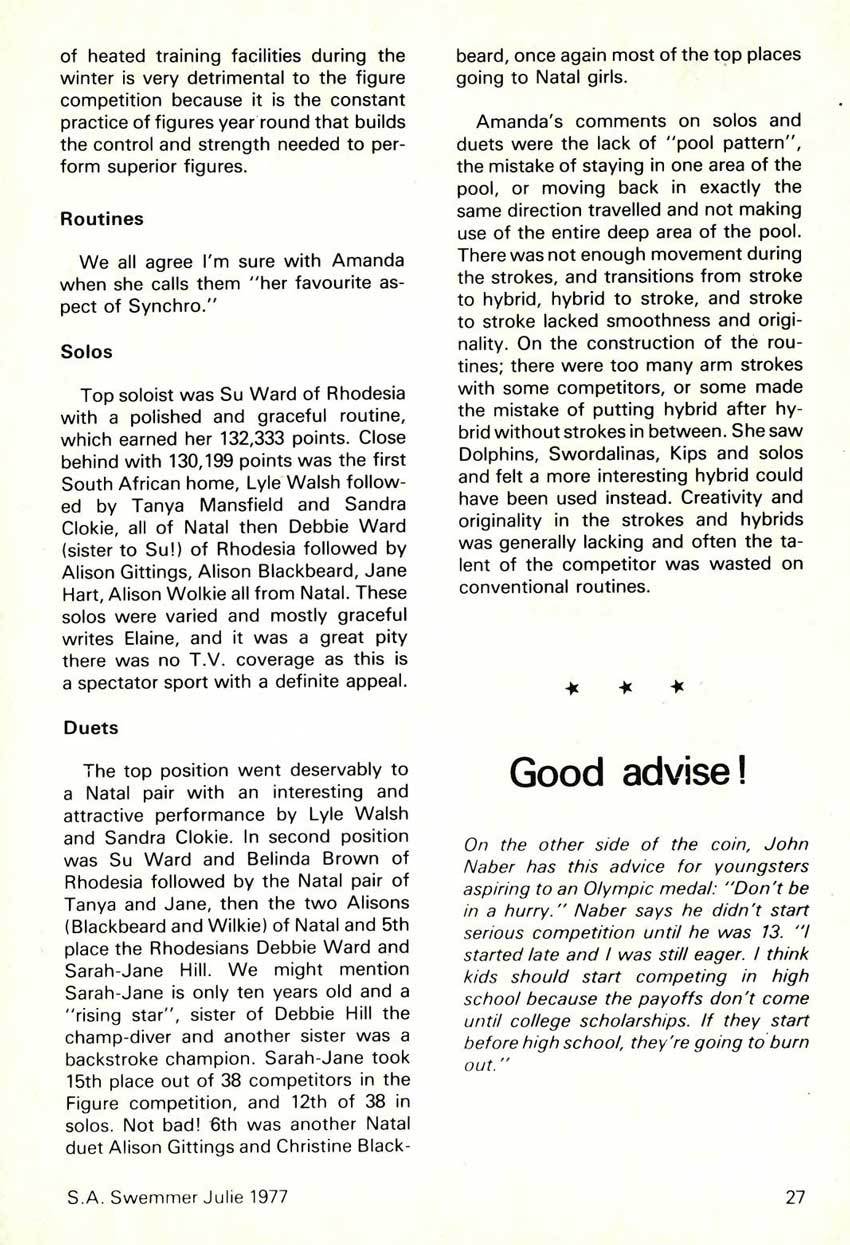
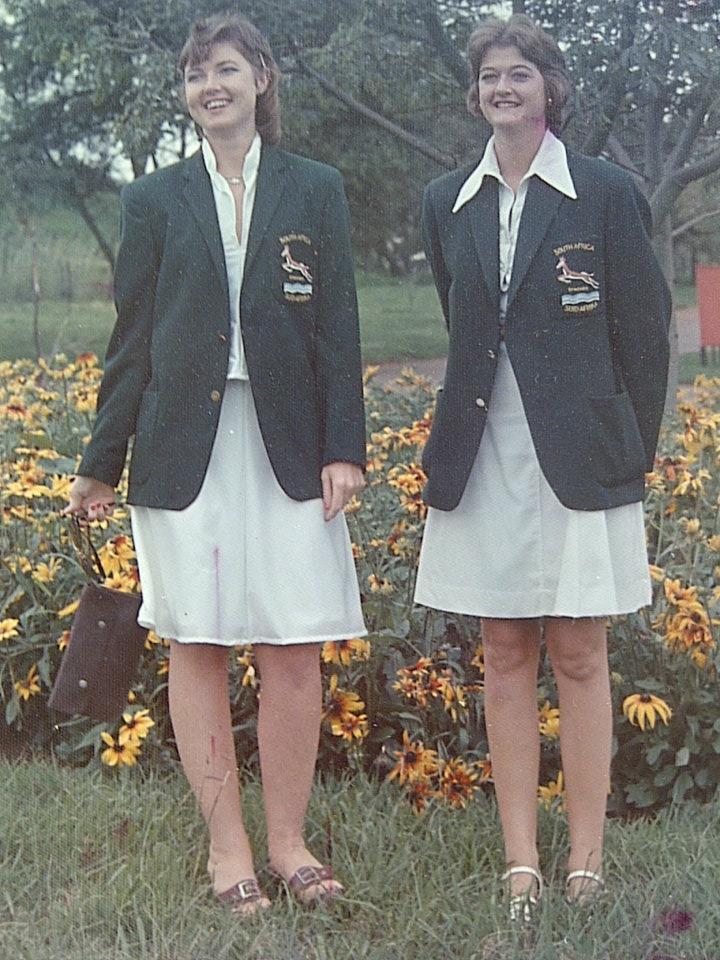
Natal synchronised swimming Springbok sisters Beverley and Aileen Martin
Cygnus Club in Durban is one of the top clubs in the country, offering synchronised swimming under the guidance of Barbara Dowell. Over the years the Cygnus synchronised swimmers have represented KZN at the SA Nationals event winning most of the top medals/trophies. Cygnus members have, over the years, represented SSA at various international events, including Olympic & Commonwealth Games. Earlier in 2008 Cygnus employed a Canadian Coach for 3 months to ensure the skill levels continued and the experience the girls gained during this time was invaluable. In June 2008 a Cygnus team of 7 members travelled to Singapore to compete in the Singapore 3rd National SS competition and brought home 4 gold medals and 1 silver medal. Many of the Cygnus members are representatives of the SA Nationals Junior and Senior teams. Cygnus has just returned from the 2008 National Age Group Championships and brought home the club trophy for the 23rd consecutive year running.
click here to see the Cygnus Centenary brochure
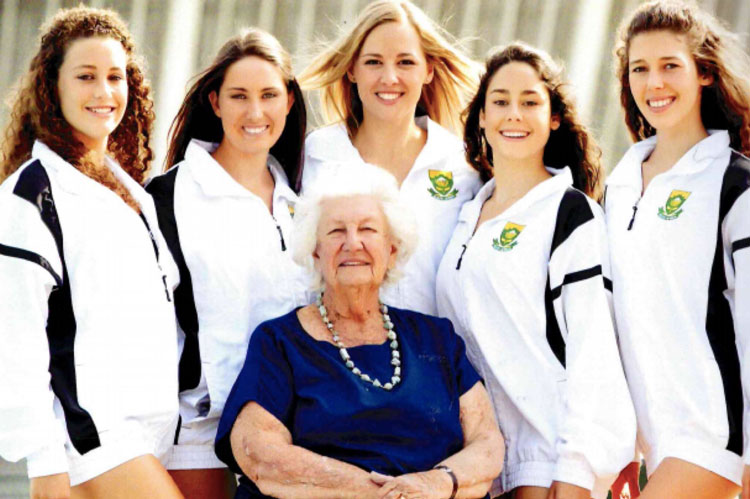
Cygnus coach Barbara Dowell with SA Synchro swimmers
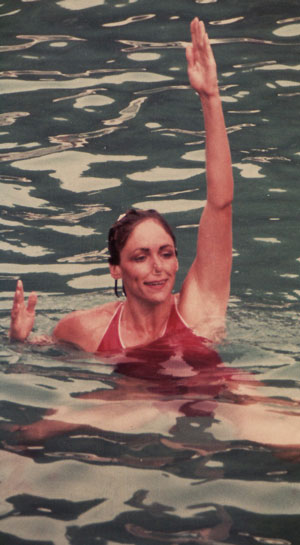
Transvaal Springbok synchro swimmer Kerry Woodhead.
22 July 2021
When Clarissa Johnston received a call from former teammate Laura Strugnell, she at first wasn’t really sure what to make of it. Strugnell was unequivocal: she wanted Johnston to come out of retirement to swim a duet with her in the hopes of being selected for the 2020 Olympic Games.
South Africa had not been represented at the Olympics in artistic swimming since 1992. For Tokyo, the nation had again earned a duet quota via the continental route at the 2019 World Championships. However, the federation had historically not accepted that quota and the athletes were convinced it would be the case again. After that summer, Strugnell decided to retire and move on.
In a random twist of fate a couple of months later, she found out while at work that South Africa actually would send a duet to Tokyo. She hadn’t been out for too long, but her former duet partner was already swimming with somebody else. Facing this once-in-a-lifetime opportunity, Strugnell thus had to quickly find a new partner.
A past national team member, Clarissa Johnston was also living and working in Cape Town. She had however completely stopped swimming in 2014. Fortunately, Strugnell made her point and convinced her to give it a try until the national trials a few weeks later. There, the winning duet would be the one selected for the Games.
A long and tough year later, Johnston and Strugnell, 30 and 29 years old respectively, won the South African trials. Coached by Vicky Drinkwater and two-time Egyptian Olympian Reem Abdalazem, they are now getting ready to fly to Tokyo in a few days. The Games will be their first international senior competition together.
Inside Synchro: Can you tell us about your respective careers in artistic swimming, and how your paths eventually crossed?
Laura Strugnell: I started synchro when I was five. I competed in every World Championships between 2011 to 2019. After these last ones, it didn’t seem that South Africa was going to take the Olympic quota, so I retired. I found out in February of 2020 that they were taking it, and that they were going to hold trials. I then contacted Clarissa, and here we are together (smiles)…
Clarissa Johnston: I started when I was 12. I actually swam with Laura on the 13-15 national team in 2005. Then in 2007, I was on the senior national team. We were competing against Egypt for the qualifying spot at the CANA Africa Olympic Trials. Reem was also there swimming for Egypt. After that, I went to Lindenwood University in the U.S. until 2013. I actually swam with Reem on the A team during the 2010-2011 season, and retired shortly thereafter. I went back to South Africa, and swam for a recreational club in 2014, more for fun. But I couldn’t fit that in with full-time work so I stopped. Then, Laura messaged me at the start of 2020, and was like, “Do you… want to do synchro again (laughs)?”
IS: Had you continued swimming or done any other sports in the meantime?
CJ: Not really. I did some trail running, and one open water swim, but nothing compared to normal synchro training. I hadn’t even continued stretching my splits, but why would I!? It was quite a shock to my body to come back and do it all again.
IS: And Laura, how did you find Clarissa?
LS: After I decided to retire in 2019, my old duet partner started swimming with another girl. Obviously, they were already together, so there wasn’t really an opportunity to go back and be with her again. So, I had to find a new duet partner. I did ask a few people that I knew, even my sister who used to do synchro, but that led nowhere. Eventually, I found out that Clarissa was living in Cape Town too. So, I just took the chance and asked her. I was very excited when she said yes.
IS: Did you have to do a lot of convincing for her to agree to return to elite after six years?
LS: Well, the word “Olympics” did help a little (laughs)! She did say that she needed to get back in the pool and try a few things before she would consider it. But I don’t know how much of an option I really gave her…
CJ: Back then, it was also only 10 weeks until the qualifiers. I was like, “You can do anything for 10 weeks.” At the time, we were the underdogs and the mindset was completely different. I was just thinking, “Let me help Laura out, do these two routines at nationals, and then we will see.” Her previous partner was in the duet we would be up against. They were almost the expected champions in a way. People didn’t think that Laura would find someone else. But then with Covid-19 delaying the Olympics and our trials, it gave us much more time to catch up and try to pull ahead.
LS: Yes, to have that extra year was really a blessing in disguise for us. At the time, we would have only had a few weeks together before trials. Maybe we wouldn’t even have made it back then…
IS: How did you manage to catch up, especially in such a complicated year?
LS: We took every opportunity that we could. Honestly, even though I didn’t take such a big break from synchro, this is the hardest I’ve ever trained in my whole career.
CJ: Lockdown was very strict here, to the point where you couldn’t even leave your house to walk your dog. We did a lot of workouts together on Zoom, and also with our coach Vicky who is based in Johannesburg. We really did anything we could find, any Instagram Live workouts or some of the U.S. team workouts on YouTube. As soon as pools reopened, we went even if we could only access the pool that was one meter deep. We worked so hard because we knew we were behind. There was never a time where we could be comfortable and take it easy.
IS: Then last April, you won both duet events at the South African trials. How did you feel, and when you realized you would indeed go to the Olympics?
CJ: It was really surreal. We actually had to wait two days to get our results because we had international judges, and they were given a few days to score. I was home alone when the email finally came through. It was amazing. For the Olympics, we still had to wait until June 24. The South African Olympic Committee (SASCOC) wanted to announce it live on national television. So, we actually waited two months until we finally got named. It was a very long wait, and we didn’t want to say much until we had it officially, especially with all the uncertainty this year. In the end, we were all together watching it at our coach’s house, so that was obviously awesome.
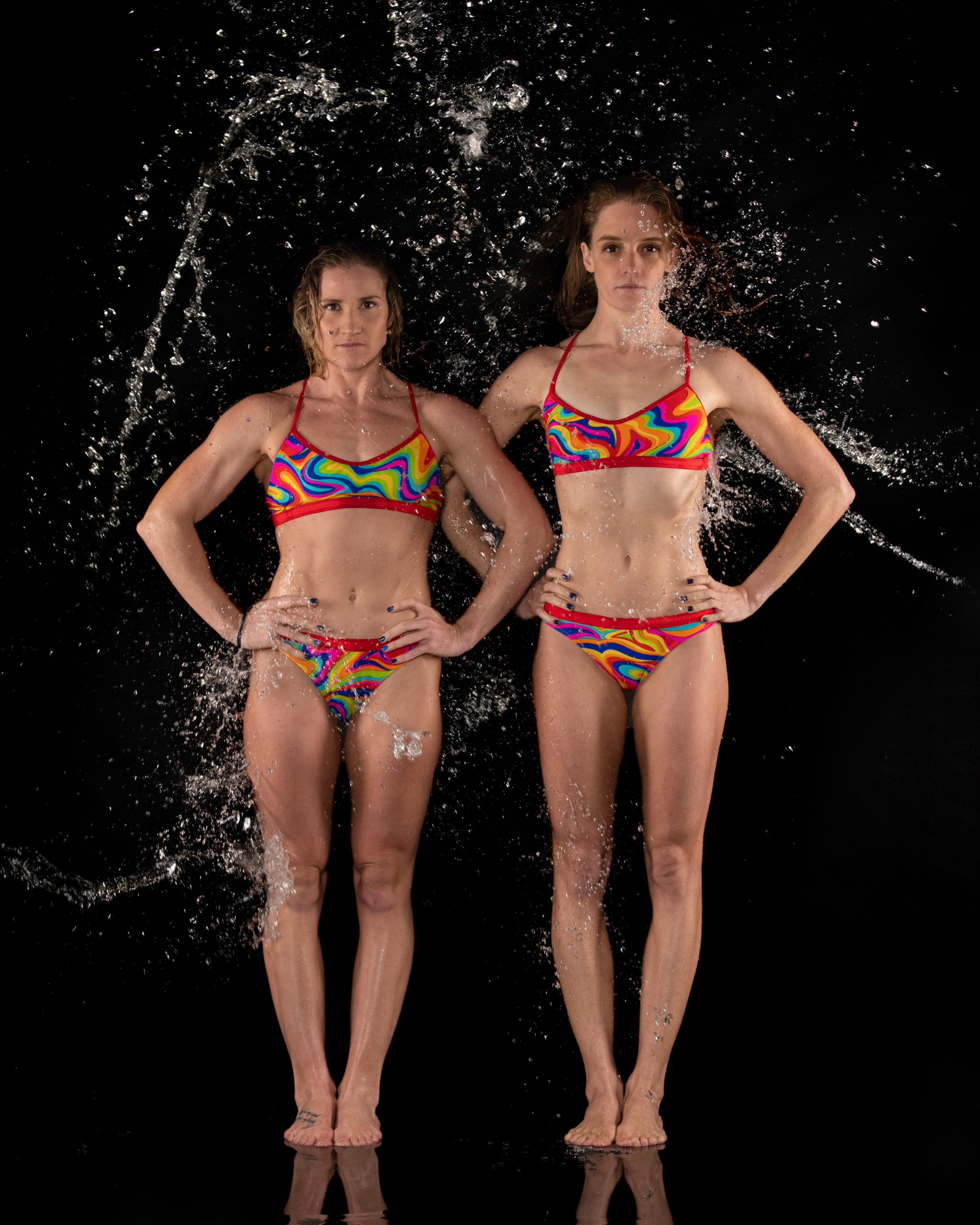
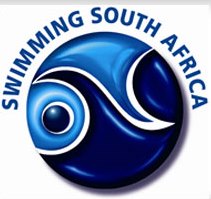
31 Aug 2024
It has refused to divulge the results of its quadrennial annual general meeting or the legitimacy of its executive committee candidates.
Swimming South Africa (SSA) held its quadrennial annual general meeting on 25 August 2024 and elected its executive committee for the next four-year term. However, several members who were nominated to be elected have served more than the three-term (12-year) limit set out by the swimming body’s constitution.
The results of the meeting have not been made public yet. SSA has ignored all Daily Maverick’s requests for transparency about the results of the meeting and the legitimacy of its nominees.
SSA president Alan Fritz once again contested the presidency, but completely unopposed. He has served as a member of the executive committee, in one capacity or another, since 2004, for a total of ve consecutive terms (20 years).
An additional four years will see him double the maximum number of terms stipulated by the constitution. Article 6.2.3 reads: “The term of oce for all executive members will be limited to three consecutive periods.” Jace Naidoo, the vice-president, was nominated to serve an additional term in the same position. He has been on the executive committee since the unification of SSA in 1999. He was president from 2004 until 2016 and vice-president from 2016, and is aiming to serve until 2028.
In 2004, Naidoo said in a parliamentary meeting that SSA had a four-year leadership cycle, and it tried to ensure that presidents served no more than two terms in order to encourage training in leadership. Instead, however, it seems the same leaders are moving from one seat on the committee table to the next, contrary to the constitution of World Aquatics, which should at least be a guiding document for SSA.
Article 18.4 of World Aquatics’ constitution specifies: “If an executive member (e.g. a president) is elected to a new position in the executive (e.g. as treasurer), any previous term served in the executive (e.g as vice-president) is counted as part of the individual’s overall term of oce…”
Also included in this re-election muddle are Zikie Molusi and John Ellis, who were up for nomination as deputy president and treasurer, respectively, despite both having served on the committee since 2012 (three terms). It appears that these nominations were in breach of both Aquatics’ constitutions.
Prior to the quadrennial annual general meeting, Matt Kemp, a registered member of SSA and director at law rm Becker Kemp Attorneys, sent a letter to the body disputing the eligibility of the aforementioned quartet to be allowed to be nominated to the executive committee.
In response, SSA CEO Shaun Adriaanse noted that Becker Kemp Attorneys is not a member of SSA. “We take note of your correspondence as attached,” he said in an email. “Kindly note that after verification we can confirm that Becker Kemp Solicitors Attorneys are not capitated [sic] as a member of Swimming South Africa.”
But Kemp is a registered member of SSA and the complainant in this matter. He sent the letter in his personal capacity. SSA is apparently playing semantics instead of addressing the issue at hand: how these executive members are continually seeking re-election apparently in breach of SSA’S own constitution. SSA members who oppose the current leaders were not invited to the quadrennial annual general meeting.
SSA and Fritz has not responded to any queries from Daily Maverick regarding the legitimacy of the members of their executive committee. Attempts to ascertain who was elected to the executive committee were also unsuccessful. The only response Daily Maverick received was a Whatsapp message from Fritz on 26 August stating that he would phone back at a later stage, which he did not do.
Although they can ignore the media (but questions and probing won’t stop), the leaders of SSA are likely to face a high court review of their conduct brought by Becker Kemp Attorneys. If there is nothing untoward in their conduct, why not show SSA’S constituents and the media the clauses in its constitution – or in any other documentation – which allow board members to serve upwards of three terms?
This method of dealing with problems is not new for SSA. In February, Daily Maverick reported on SSA’S decision not to send the national men’s and women’s water polo teams to the Paris Olympics. Adriaanse said SSA did not believe that either team was good enough to win a medal at the Games and therefore should not go – despite qualifying as Africa’s best. He did not respond to further queries. Current and former water polo athletes and coaches told Daily Maverick they were mistreated by SSA after the publication of the story.
Adriaanse, however, chose not to respond to any of the accusations. Daily Maverick asked for a high-performance plan for water polo from SSA for the next Olympic cycle to ensure the team would be deemed “ready” for Los Angeles 2028. There has been no response to this request, which was made at the end of February.
Daily Maverick’s correspondence with former women’s national water polo coaches Sarah Kravitz and Delaine Mentoor – who were removed from their positions without clear reasons – showed that SSA is accustomed to cutting communication. A stuttering state SSA has had an error-ridden record with the current executive committee at the helm. Breaststroke swimmer Lara van Niekerk (21) swam the qualifying times for the 2024 Paris Olympic Games at nationals in 2023, which falls in the Olympic qualifying period.
But SSA made a clerical error that meant the nationals was not registered as an ocial Olympic qualifying event. Van Niekerk was a medal hopeful in the 100m breaststroke – her personal best time is only just o what teammate Tatjana Smith swam to take gold in Paris.
Artistic duo Laura Strugnell and Jessica Hayes-hill’s chances of competing at the Olympic Games were also ripped out from under them after they were sent home from the swimming World Championships in Doha – an Olympic qualifying tournament – at the start of the year.
SSA did not provide a reason for their dismissal. The athletes appealed the decision and won their appeal. This follows the decision not to send the men’s and women’s water polo teams to the Olympics for dubious reasons after setting an arbitrary qualifying standard at the World Championships. Athletes in both teams claimed to be unaware of it until after the fact.
SSA’S executive committee and the sporting disciplines it serves look likely to have another four-year period together, despite their own constitution not supporting it. SSA is apparently playing semantics instead of addressing the issue at hand: how these executive members are continually seeking re-election apparently in breach of SSA’S own constitution
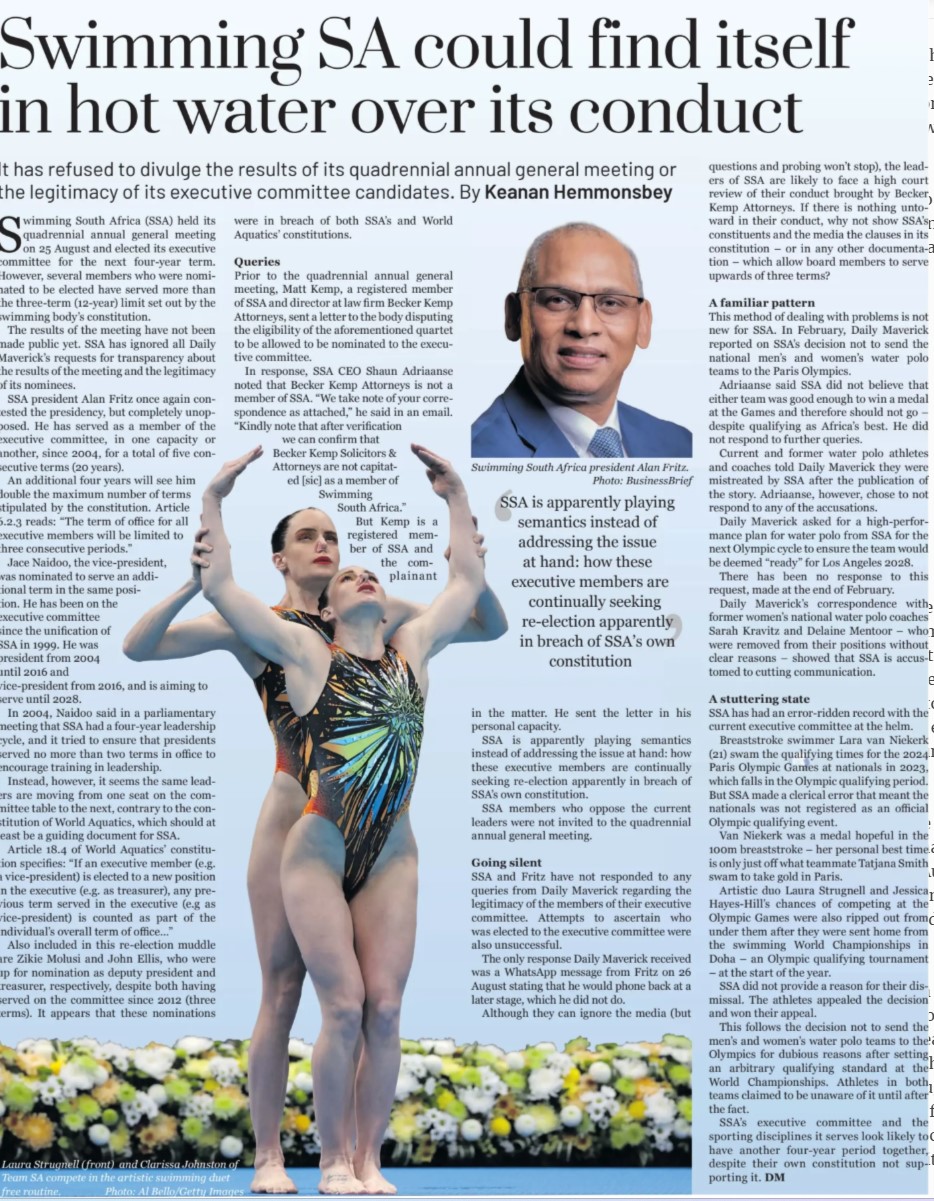
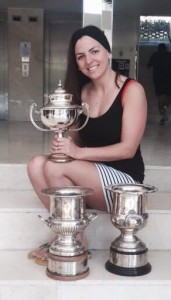
Kerry Norden
FINA World Championships - 2011, 2013, 2015
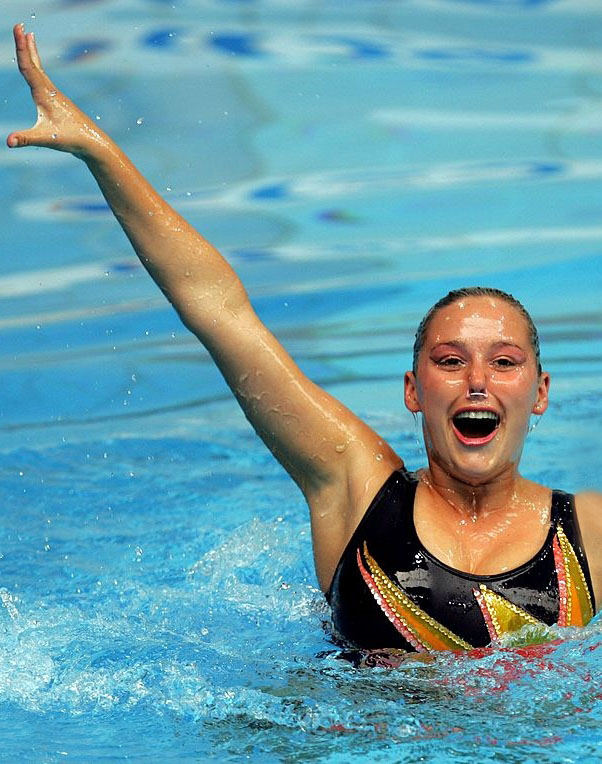
Shannon Crowder
18th Commonwealth Games 2006 and 2011 FINA World Championships
In June 2022 history will be made in the artistic swimming (formerly synchronised swimming) pool as Ayrton Sweeney becomes the first man to represent South Africa in the sport. Having represented the country in swimming for numerous years, Sweeney made the switch a few months ago and will compete in the mixed duet with Laura Strugnell.
“I think Ayrton can vouch for the fact that he had no idea what he got himself into until he was in because it was very different to the training and competition prep he was used to, but he has taken this challenge and succeeded,” said Strugnell, who represented the country at the Tokyo Olympics last year.
“I love swimming with him, I laugh for almost all of the session and I don’t think there is another male swimmer I would rather swim with,” she added.
The swimming programme in Hungary will take place from 18-25 June with the diving being contested from 26 June-3 July. Open water swimming will take place from 26-30 June. Artistic swimming will be contested from 17-25 June with the men’s and women’s water polo tournaments being played from 20 June-3 July.
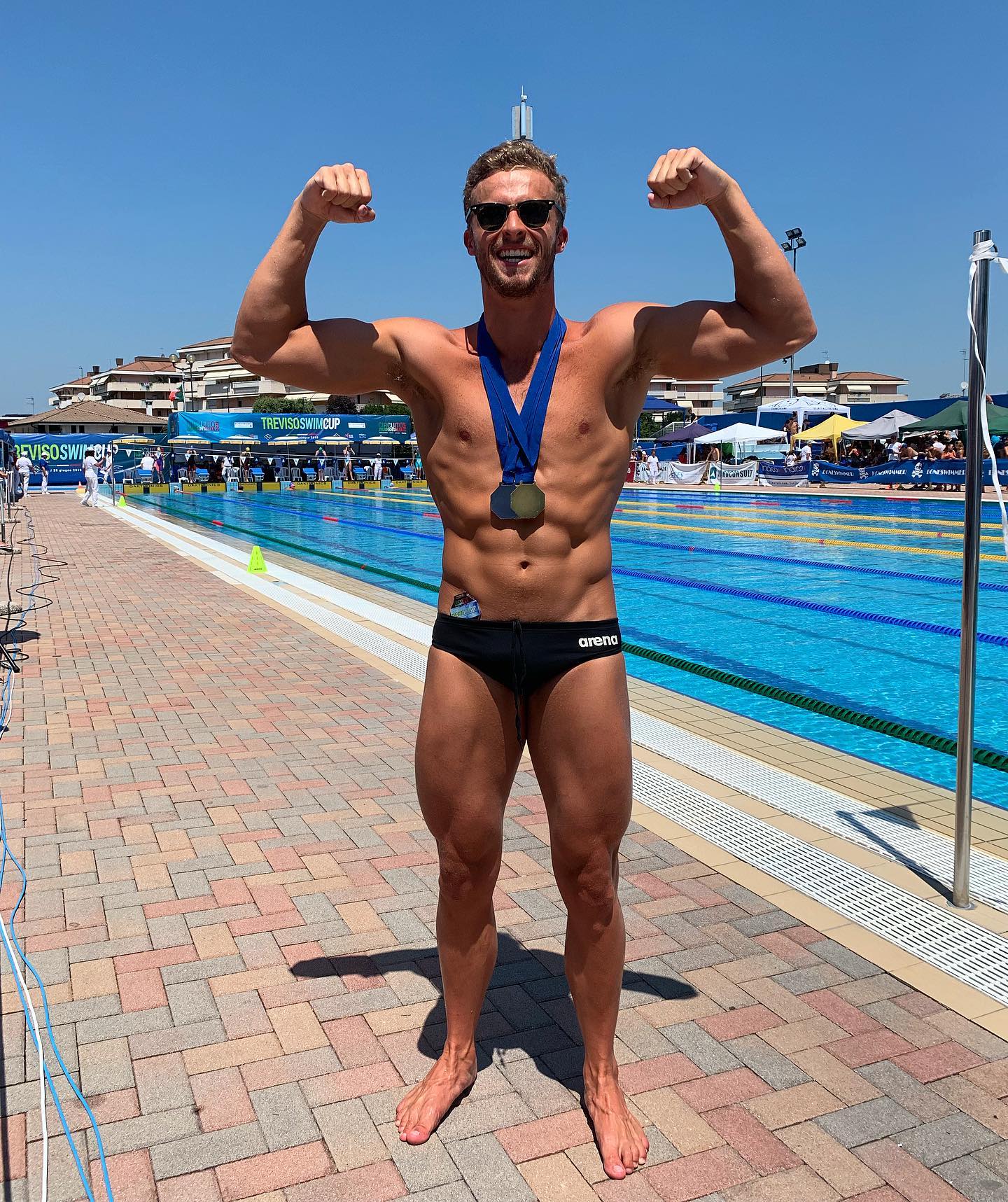
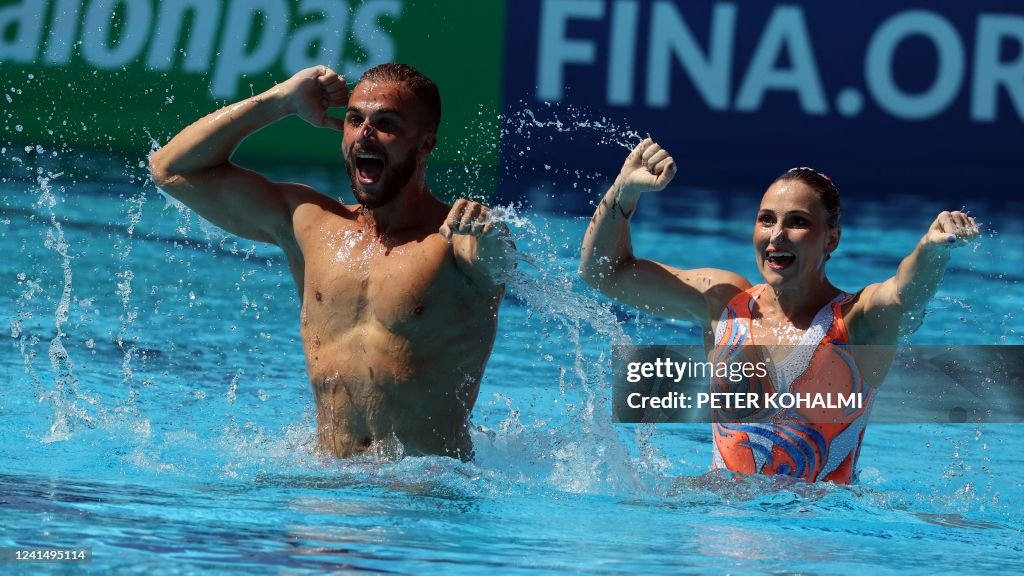
South Africas Laura Strugnell and South Africas Ayrton Sweeney compete in the preliminaries for the Mixed Duet Free artistic swimming event during the Budapest 2022 World Aquatics Championships at the Alfred Hajos Swimming Complex in Budapest on June 24, 2022.
Collegiate GHS in Port Elizabeth and Wynberg GHS in Cape Town.
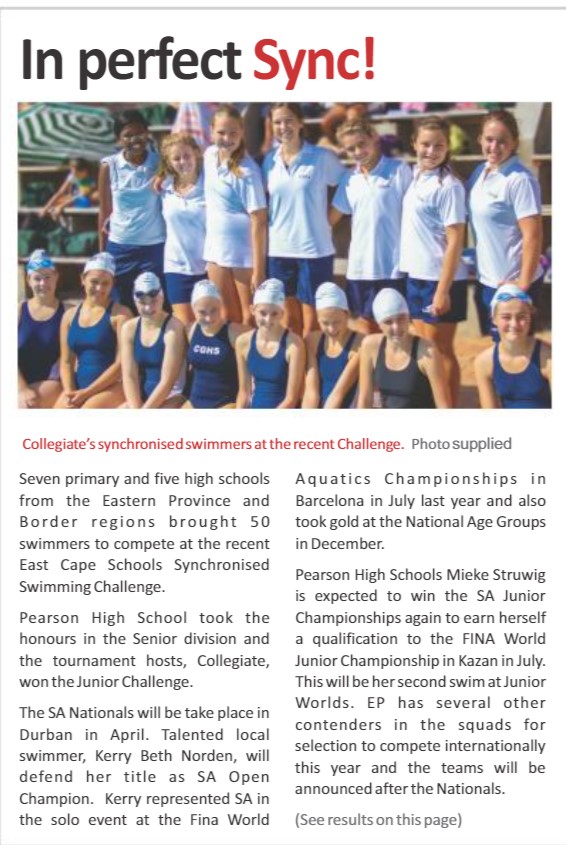
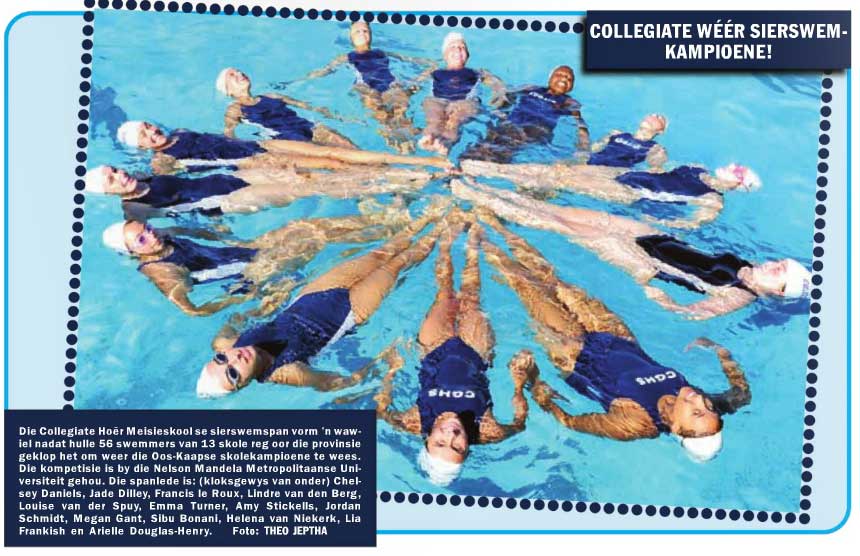
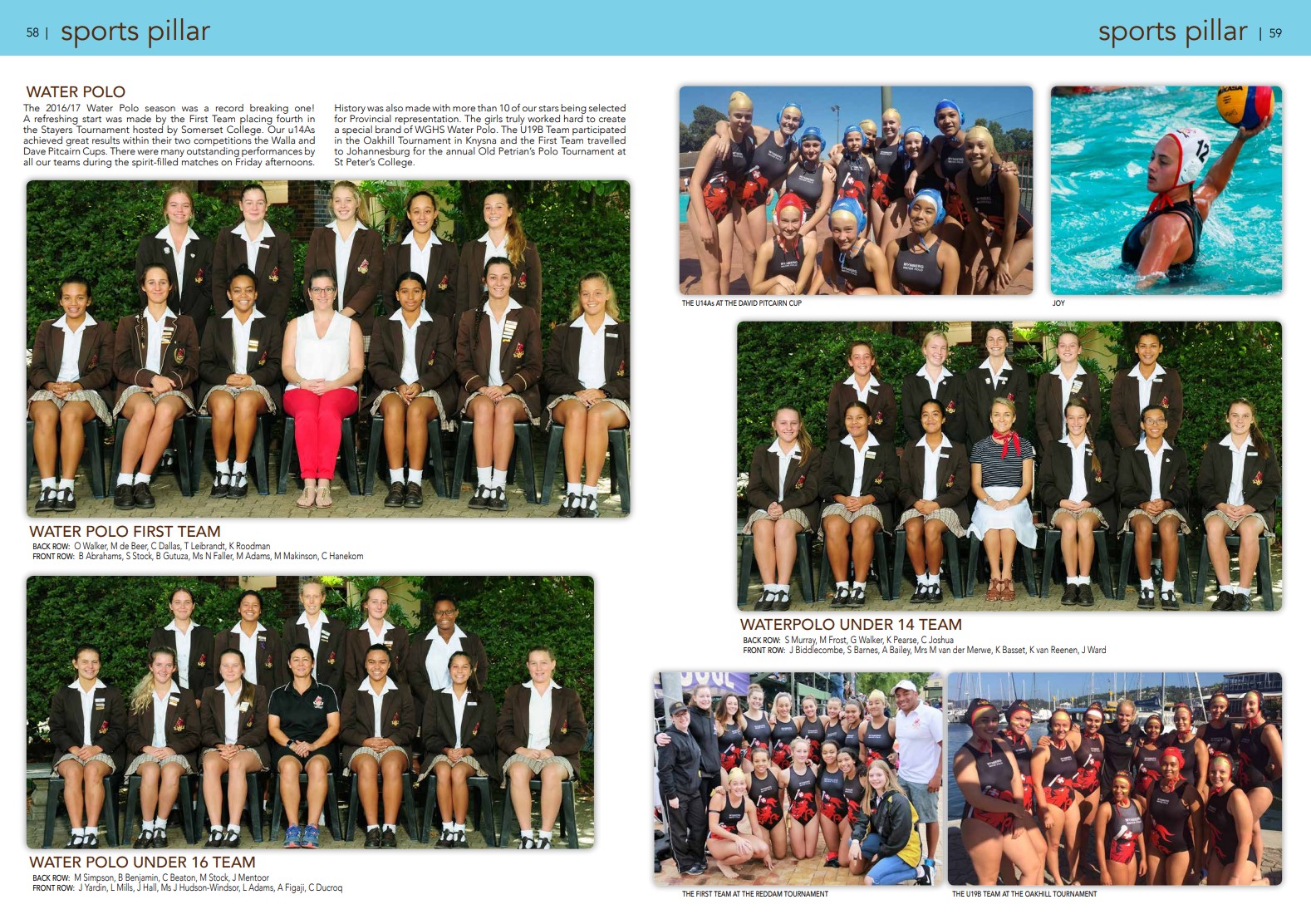
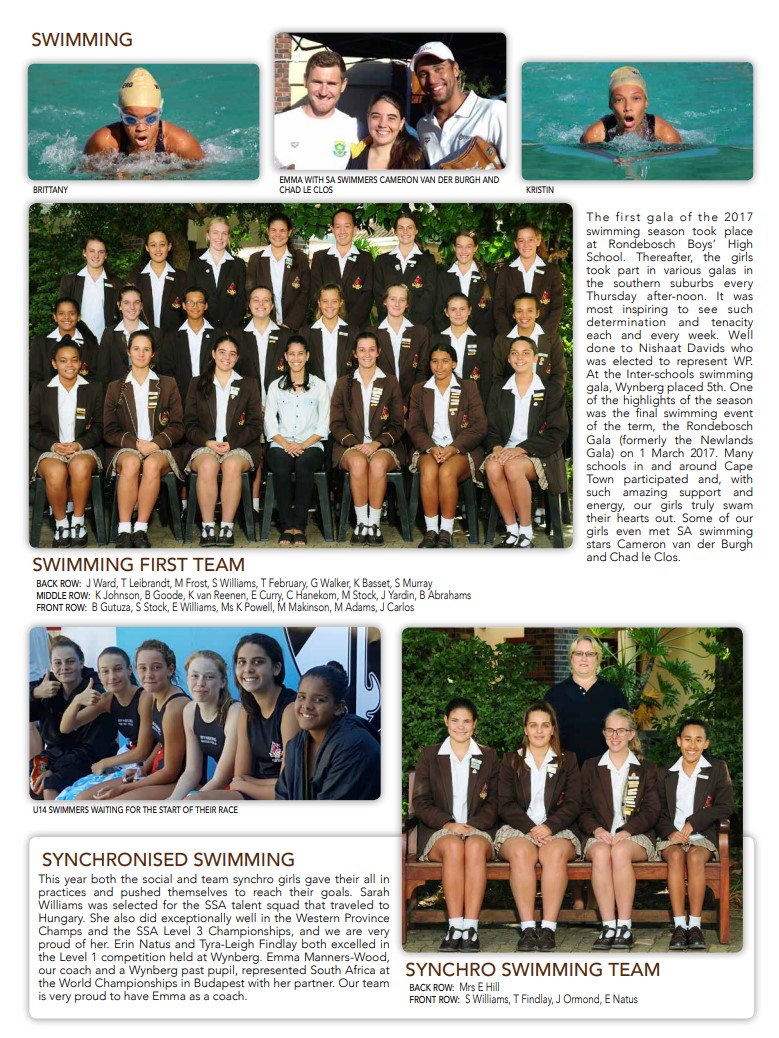
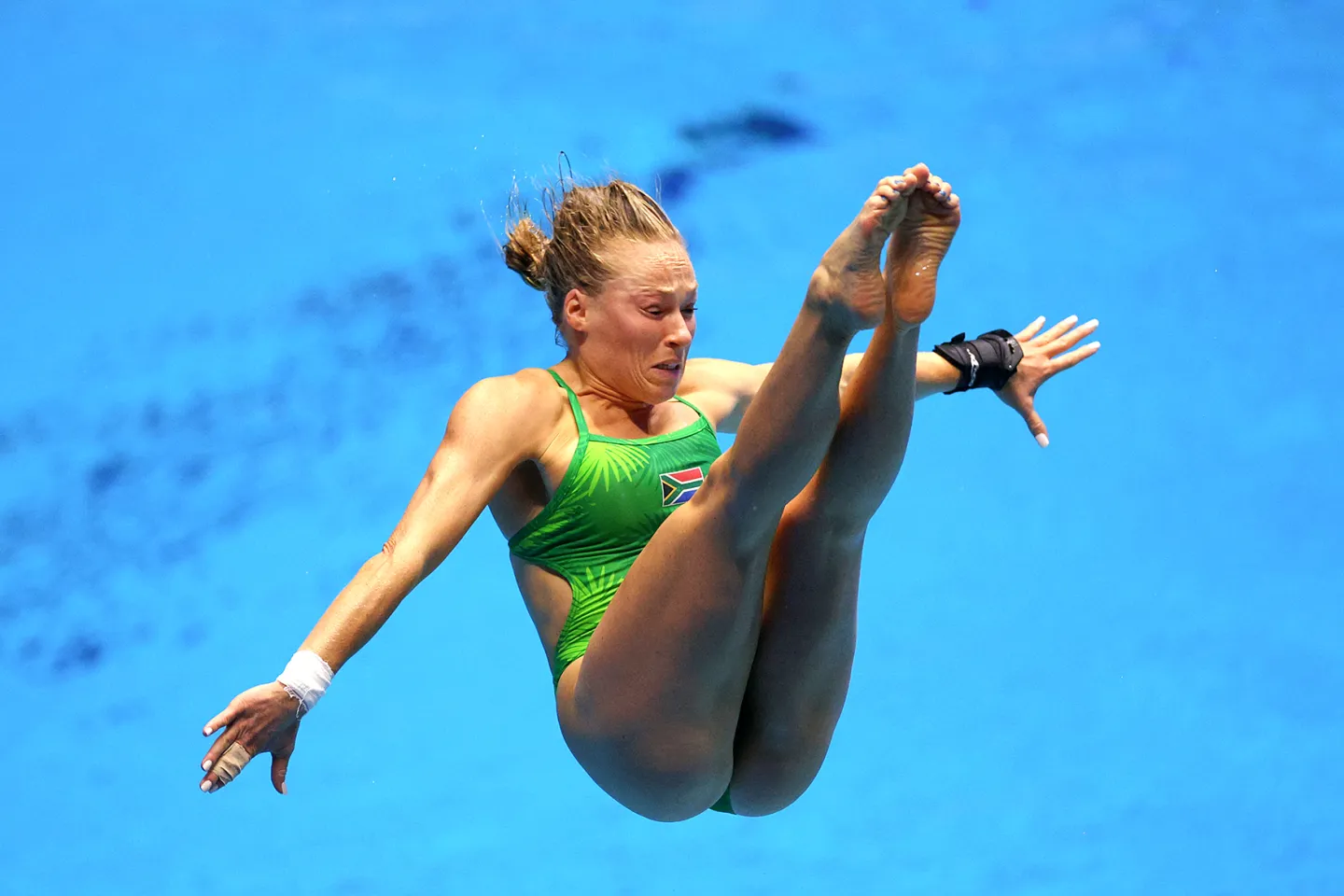
Julia Vincent of Team South Africa competes in the Women's 1m Springboard Preliminaries at the Fukuoka 2023 World Aquatics Championships at Fukuoka Prefectural Pool on 14 July 2023 in Japan. Paris 2024 was to be Vincent's final Olympics.
By Robert Michael MacLean
This study was carried out in partial fulfilment of the requirements of the B.A. Honours Degree in Physical Education, Rhodes University, Grahamstown, R.S.A., 1977.
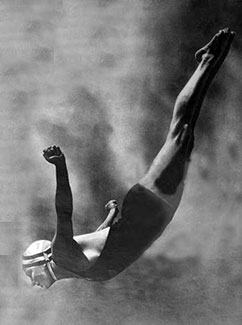
Oonagh Wittsitt - Gold Medal winner at the 1930 Empire Games
Springboard diving became a competitive sport in South Africa in 1922. In 1923, on the recommendation of a Mr Jimmy Green, a well-known South African swimming coach, an international-type springboard was imported from the USA and was installed at a swimming pool in Messina, Far Northern Transvaal. The following year, Green persuaded the Pretoria Municipality to import and install a similar board at their municipal baths. (It should be noted that England did not have an internationally recognized type of springboard until 1923 and so Green’s initiative would therefore seem to have opened the first chapter in the history of South African diving – though one cannot help but wonder why SA’s first ever international diving board should have been installed in Messina!
South Africa’s next step forward was the gaining of the F.I.N.A. Handbook containing the rules and regulations governing the sport at International competitions – notably, the Olympic Games – and this occurred in the mid-1920s. A study of these rules made plain the hitherto imperfectly understood things concerning diving technique and the manner in which diving competitions should be conducted.
Following the 1932 Olympic Games, in Los Angeles, USA, P.J. Grobbelaar, of the South African team and Manager of the 1932 SA team to these games, brought back from the United States films of the Olympic divers in action as well as plans of the actual equipment used in the competition. The difference between this equipment and the aforementioned boards (in Messina and Pretoria), lay in an improved type of movable forum, which increased the flexibility of the board. The University of the Witwatersrand (Wits), working to the specifications of the Los Angeles equipment, installed diving facilities at the university pool and ding found a permanent home in South Africa.
Following the 1936 Berlin Olympic Games, the Wits University swimming club imported a film on the mechanics of diving, showing the American, Harold Smith (Silver medallist, 1932 Olympic Games), in action. As this film was in slow-motion and covered all the dives contained in the (1936) diving tables of the F.I.N.A. Handbook, it provided an invaluable visual medium through which modern diving techniques could be studied and taught. Wits, using W. Bohlander, the 1940 SA diving champion, made a similar film, where Bohlander demonstrated his interpretation of Smith’s mechanics of springboard diving. This and the film of Smith was then used prior to teaching and coaching diving and divers, initially at the Wits pool and later, throughout South Africa, where they certainly stimulated interest in the sport.
With the collaboration between the Johannesburg Schools Amateur Swimming Association and the Wits Swimming Club (1946), diving at high school level on the Rand began to flourish and this found expression with the Diving Officials Courses of Instruction that was offered to school teachers who wished to become proficient in the teaching, coaching and judging of the sport.
December 1947 saw members of the Transvaal A.S.A. partake in a diving course, organised by Wits University S.C., which was the beginnings of a diving standardization programme for judging in South Africa. This was an important factor in the establishment of the sport proper, for, before this, the rules governing diving judging were not always fully understood, with the result that marks awarded sometimes varied within the competition to the point of being most unsatisfactory. (This still happens – a human failing no doubt – witness the discrepancy of 4.5 points between judges on Martin Lundie’s Reverse 2 ½ at the Durban National, 1976!).
However, with more qualified persons to their disposal, the provincial A.S.A. bodies were now able to go about conducting competitions with a high degree of efficiency. About this time, the Kingfisher Diving Club, the first diving club to be formed in South Africa, was established in Port Elizabeth and at the St. George’s Park Swimming Pool. Strongly backed by the Eastern Province A.S.A., from these early years, Kingfisher Club has turned out many exciting divers, several of them South African champions.
Top of their present list is Barry Birkett, present holder of the Men’s 1m diving title as well as being the 3m title holder in 1974 and 1975. Headed by some of South Africa’s top diving coaches and administrators such as John Pemberthy (himself a Rhodesian and Springbok diver), Peter Defferary (also Rhodesia and South Africa) and his wife Ursula, this club started out under the auspices of such well-known names to South African swimming sports as Alex Bulley, Rae Smit (nee’ Walker) and Geoff Mandy, the 1948 Olympic Games Springbok diver. This club, over the years, has and still does arrange diving competitions, courses and seminars for competitors and officials, in the continuing attempt to boost their sport in this country.
In the history of South African diving prior to 1950, only a few names come readily to mind, among them being H.W. Harris of Natal, F.A. Brandt, W, Bohlander and Cliff Lubbe of Transvaal, Geoff Mandy of the Eastern Province and Willie Welgemoed of Northern Transvaal. The same also holds for women’s diving. Very few women applied themselves to this sport in South Africa prior to the 1950’s although pride of place for these times goes to Oonagh Whitsitt, the 1930 gold medallist at the Empire Games of that year.
Geoff Mandy, who competed at the 1948 Olympic Games in London and who held the S.A. title from 1946 to 1949, was the first male diver from South Africa to represent his country overseas. During the 6 years he spent with the South African Forces during World War II, he had the opportunity of seeing and competing against the best divers in the world in the Middle East. He also has the honour of being selected to compete for the Mediterranean Area Team against The Rest of Europe during his army service. A fine sportsman and one was a real credit to this country in the diving world, Mandy lost his SA title to Willie Welgemoed in 1950, who was to become the next male South African diver to compete in the Olympic Games and that was in Helsinki in 1952.
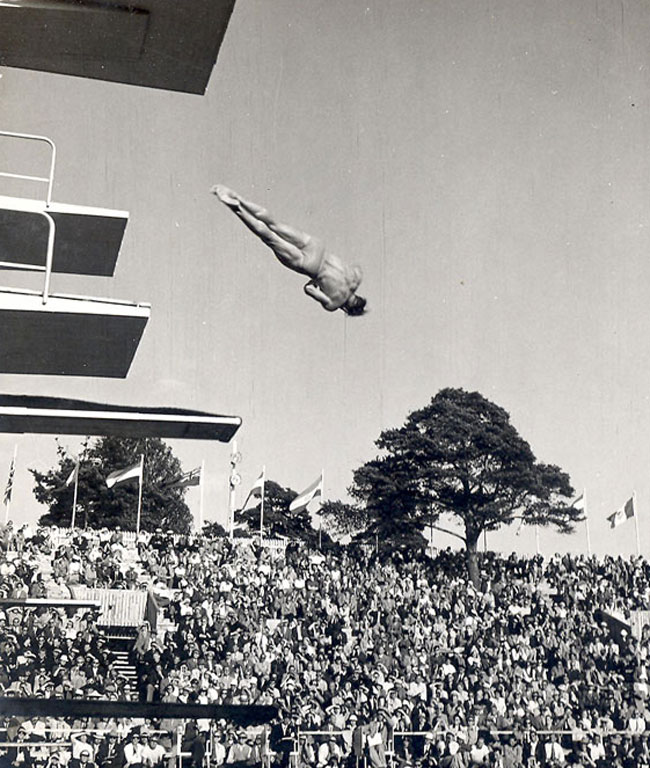
Willie Welgemoed at the 1952 Helsinki Olympic Games.
Welgemoed, who won the national title until 1955 (Basil Bowen won in ’54), had this written of him following his performance at the ’52 Games, by Mr SA Swimming, Alex Bulley, himself….”W. Welgemoed, Men’s springboard diving. 22nd place, 61.64 points. Welgemoed failed to qualify by 9 points on his first 6 dives. The Americans who took the first three laces were outstanding, but I felt that Welgemoed should have held his own with the other competitors. I think that Welgemoed put his best efforts into his final training practices and his failure to reproduce form in the competition was due to his nervous temperament”…..
During the 1950’s, men’s diving in South Africa was dominated by Welgemoed (N. Tvl), Basil Bowen (N. Tvl) and Tut Marwick (Natal), who represented South Africa at the 1958 Cardiff Empire Games. In women’s diving circles, P. Chapman of the Transvaal, W. Almond (also Tvl), S. Bands and Jean (nee’ Bands) Ward of Natal dominated.
The arrival of Sandra Morgenrood (below), Rhodesia, who won the women’s 3m title in 1959 was the beginning of a Rhodesian dominance of the diving scene in southern Africa, which still persists, broken only by the fact that Rhodesians no longer compete as official competitors at the SAASU National Championships, but as invited guests. However, a brief reference to the appendix will show that they still have the better of their South African opponents.
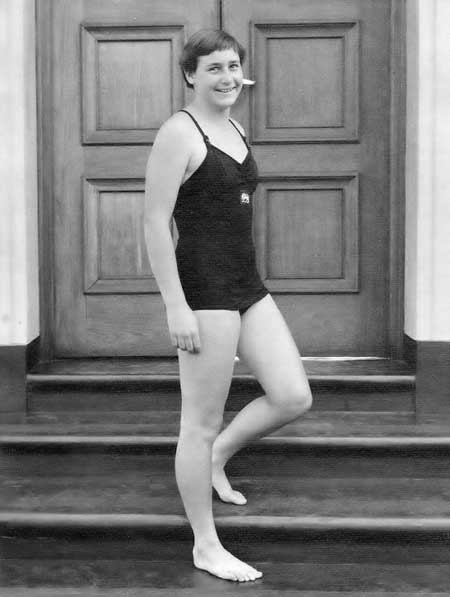
Sandy Morganrood - 1960 Rhodesian Olympic Diving Team Member, Rome
Prior to the 1950’s, Rhodesia had only produced one South African diving champion and that was Freddie Gibbs who won the title in 1929. The emergence of Rhodesia as a diving nation began with the advent of Ian Grace being selected to represent Rhodesia at the 1950 Empire Games. A forward-looking policy by administrators in the late ‘50’s saw a blossoming of this branch of aquatic sports in Rhodesia and by this time a solid cadre of coaches was very active in the country and in all ten major centres; to wit, Gordon Bridger and Chris Theodosiou in Bulawayo, Val Butler in Umtali and Pat Morgenrood and Ron Ward in Salisbury.
From this time onwards , Rhodesia became increasingly interested in diving and competition in the larger centres became keener with divers having to improve their techniques and degrees of difficulty to keep up with their opponents. Diving officials and coaches also had to improve their knowledge to keep in line and this naturally had a very positive effect upon the sport.
Without the keen interest of all these individuals, diving could never have progressed as it did. South Africa was behind in this respect for many years and this allowed Rhodesia to dominate the scene. However, having to take this ‘back-seat’, encouraged South African divers to improve their standards and this has certainly been evident in the 1970’s.
In 1973, several of South Africa’s top divers and well as budding potential champions, dissatisfied with how diving was being run in South Africa, broke away from the S.A. Amateur Swimming Union (SAASU) and led by a former national champion, Ernst de Jong, formed the South African Diving Union (SADU) with its headquarters in Pretoria. The reason for this breakaway, to quote de Jong, was to improve the lot of SA’s divers, who were getting a raw deal facilities-wise and international competition-wise, from SAASU.
Said de Jong….”we had our own diving centre cat New Muckleneuk in Pretoria; a pool 5 m deep with two 3m diving boards and four 1 m diving boards. My brother, Gerrie, built it out of his own pocket. When the National Film Board commissioned me to make an instructional film on diving, I had a ready-made set. I shot half the movie at New Muckleneuk, using Gina Lawrie and Robin Lieberman as the stars and the other half at the Rhodesian/South African International last year (1975). We arranged tests against the Rhodesians to give our divers an incentive. We designed our own Springbok colours (and badge) and awarded them to Gina Lawrie, Joe Thewliss and Martin Lundie for the first test.
We introduced group programmes so that juniors would not have to struggle against seniors as they did before. Having a union still didn’t bring us what we wanted most of all, the respect of the swimming officials. In fact, they showed less interest in us and we went on encountering poor facilities”…. De Jong kept SADU alive for two years; exasperating years when progress was an uphill task and when he disbanded SADU in late 1974, all that progress was nullified. ….”all the top divers, including the Rhodesians, quit the sport rather than going back to competing under SAASU. Today, diving is in a worse condition that it was before we launched SADU”…..
However, it seems that there was more to this breakaway besides poor facilities, but it is not my lot to argue one way or the other whether de Jong was right or wrong. What is apparent, is that he was (perhaps still is) intensely interested and keen on diving and what he did was what he thought was best for South African diving.
One this that must be countered though is in his last statement, for the Rhodesians did not quit and neither did at least two of his SADU stars, to wit, Martin Lundie who has since won his Springbok colours and is the current men’s 3m title holder and Joe Thewlis, who represented S.A. in the annual diving test match against Rhodesia this year. Added to this, S.A. Diving, under the leadership of men like John Penberthy, Peter Defferary and Vic Mijon, is on the ‘up’. Where the biggest problem exists, is in that area pointed out by de Jong – facilities.
Even though South Africa has a climate almost second to none in the world, indoor diving facilities with heated pools are need if divers are to compete at the highest level of international competition. That the talent is here is borne out by Ken Mullin’s statement on his return from the Montreal Olympics……”what a great pity it is that our top divers cannot participate at the Olympic Games. From what I saw during my visit to Montreal, they certainly would not have been embarrassed and would definitely not have finished last in the preliminaries”…… In other words, they would have been in the top twenty in the world – that is extremely encouraging.
A further important factor concerning diving in southern Africa was the break between Rhodesia and South Africa in 1972, which continues today (1977). With South Africa and subsequently Rhodesia, out of favour with F.I.N.A. for political reasons, it was decided to suspend Rhodesia from entering the S.A. National Championships as formal competitors and instead inaugurate annual test matches between the two countries in an attempt to at least meet some form of international competition.
At these tests, all four of the aquatic disciplines (diving, swimming, synchronized swimming and water polo) are contested and yet, apart from 1974, when Rhodesian divers did not attend the S.A. Nationals, they have dived regularly as invitees and have continued to rate tops in both the men’s and women’s events.
However, 1977 saw a strong S.A. side extend the Rhodesians, especially in the men’s events, when they took 2nd, 3rd and 4th places on both 1m and 3m boards. David Parrington, winning both the 1m and 3m contests, managed to salvage Rhodesia’s pride. In the women’s event though, Rhodesia again continued to dominate with Debbie Hill leading the way with her usual immaculate and imperturbable performances.
Ironically, her main opposition from South Africa was Lesley Smith, a former Rhodesian and South African Champion who was diving for South Africa by virtue of her student status in that country. 1959 saw the entry into the S.A. diving programme of a 1m championship. Such an event does not occur in major overseas contests where competition is limited to tower (10m) and 3m springboard.
However, in S.A., very few pools offer tower facilities and for this reason, S.A. diving has remained at a low level – equipment-wise! Since the inauguration of the 1m event, the Rhodesians have completely dominated, with Sandra Morgenrood beginning the Rhodesian women's run of victories in 1960, through to Debbie Hill in 1977 (unofficial of course, at S.A. national level) and Tony Steele, 1960, through to David Parrington for the men. In 1975 a handsome trophy for the 1m champion was presented and is named the Selwyn Hilton Katz Memorial Trophy. This trophy has been won on every occasion it has been contested (at the time of writing - 1977) by Barry Birkett of the Eastern Province.
A further reason for the continued Rhodesia diving excellence has been the fact that they have been able to ensure their divers of international competition through the years, in spite of world's political opinion and the laurels for this must be laid at the door of the Jester’s Club. This club consist of past and present Rhodesian champions and champion coaches, who have, through coaching clinics and membership fees, been able to sponsor (with the help of the Rhodesian Amateur Swimming Association – R.A.S.A), the visits of various overseas diving stars to Rhodesia, where they have dived competitively against Rhodesian’s, held coaching clinics and generally stimulated interest in the sport.
It is noted that S.A. is now doing the same thing, although this appears to be handled either through the Department of Sport or the Southern African Sports Foundation. It is hoped that this continues, for it can only be beneficial to divers in this country. It has already been stated that several South Africans, namely, Oonagh Whitsitt, Geoff Mandy, Willie Welgemod and Tut Marwik, have represented S.A. overseas in international contests. So too have the Rhodesians, beginning with Ian Grace in 1950. Amongst them was Lindsay Grant-Stuart, who won a bronze medal at the 1962 Empire Games and, with Terry Rossiter, represented Rhodesia at the Tokyo Olympic Games in 1964.
Perhaps the finest divers to have come out of Rhodesia have been the Lieberman cousins, Don and the late Robin, Sarie Bezuidenhout and Lena Woodard (nee’ Pretorius). The Liebermanns and Woodard were members of the ill-fated Rhodesian Olympic team that travelled to Munich in 1972 and were then denied the chance to compete because of the political line taken by so many other nations attending.
How they would have performed is pure speculation, because on the day there are many things that can go right or wrong, but it makes one think when one considers that the American, Ann Peterson, the bronze medallist of the Mexican Olympic Games of 1968, was given a torrid time in competition when she dived against both Bezuidenhout and Woodard in 1972.
Similarly, when the American, Craig Lincoln, the Munich ’72 bronze medallist visited Rhodesia in 1976, he was well beaten by Robin Lieberman. The critic might always say that the two examples quoted had several years behind them since their triumphs at different Olympiads, but this doesn’t alter the fact that this little country has had, and we hope will continue to have, immense diving talent.
Rounding off the international scene, the following Rhodesia divers have competed at the highest levels (excluding Olympic and Empire Games):-
1966 – Terry Rossiter – 2nd place, British Championships, 3m. 1966 – Lindsay Grant-Stuart, 2nd place, British Championships, 3m. 1972 – David Parrington, 3rd, World Age Group Championships, 3m.
Of further interest in S.A. diving circles was former Springbok Willie Welgemoed’s presentation of two beautiful Mexican sombreros to S.A. Diving, to be awarded to the men and women who score the highest number of points on any one dive during the S.A. National Diving Championships. These are floating trophies and since their inception in 1969, the following divers have won the trophies named, “Sombrero Willie” for the men and “Sombrero Ann Senorita’ for the women: -
Sombrero Willie. 1969, 1970, 1971 – Don Lieberman. 1972, 1973 – Robin Lieberman. 1974, 1975, 1976, 1977 – Barry Birkett. Sombrero Ann Senorita 1969, 1970 – Lena Pretorius 1970 – Dottie Armstrong 1971, 1972 – Lena Pretorius 1973 – Gina Lawrie 1974, 1975 – Elaine Parker 1976, 1977 – Debbie Vaughan.
S.A. Diving Champions – 3m Springboard – Men. 1922 – N.V. Oxenden 1923 – 1928 – H.V.Harris (Natal) 1929 – P.W. Gibbs (Rhodesia) 1930 – A.S. Alty (Natal) 1931 – H.E. Buckley (Western Province) 1932 – 1933 – F.A. Brandt (Transvaal) 1934 – 1939 – C. Lubbe (Transvaal) 1940 – W. Bohlander (Transvaal) No Championships during the war years, 1941 – 1945. 1946 – Goeff Mandy (Transvaal) 1947 – 1949 – Geoff Mandy (Eastern Province) 1950 – 1953 – Willie Welgemoed (Northern Transvaal) 1954 - B. Bowen (Northern Transvaal) 1955 – Willie Welgmoed (Northern Transvaal) 1956 – 1957 – B. Bowen (Northern Transvaal) 1958 – 1959 – C.T. Marwick (Natal) 1960 – Ernest de Jong (Northern Transvaal) 1961 – Tut Marwick (Natal) 1962 – 1963 – K.J. Mullen (Natal) 1964 – 1966 – T. Rossiter (Rhodesia) 1967 – 1968 - D. Lieberman (Rhodesia) 1969 – T. Rossiter (Rhodesia) 1970 – 1972 – D. Lieberman (Rhodesia) 1973 – Robin Lieberman (Rhodesia) 1974 – Barry Birkett (Eastern Province) – Rhodesia did not compete. 1975 – B. Birkett (Eastern Province). D. Lieberman (Rhodesia) overall winner. 1976 – Martin Lundie (Transvaal). D Parrington (Rhodesia) overall winner. 1977 – M. Lundie (Transvaal).
S.A. Champions – Men’s 1m. 1960 – 1963 – T. Steele (Rhodesia) 1964 – 1966 – Terry Rossiter (Rhodesia) 1967 – 1971 – D. Lieberman (Rhodesia) 1972 – 1973 – R. Lieberman (Rhodesia) 1974 – B. Birkett (Eastern Province). Rhodesia did not compete. 1975 – the Selwyn Hilton Katz Memorial Trophy is awarded for the first time. Recipient – B. Birkett (Eastern Province). D. Lieberman overall winner. 1976 – B. Birkett (Eastern Province). D. Parrington (Rhodesia) overall winner. 1977 – B. Birkett (Eastern Province). D. Parrington (Rhodesia) overall winner.
S.A. Champions – Women – 3 m. (The S.A.A.S.U. Women’s S.A. Diving trophy was presented by Marjorie Harris in 1945). 1922 – M. Harris (Natal) 1923 – 1924 – W. Johnstone (Western Province) 1925 – 1926 - M. Harris (Natal) 1927 – O. Whitsitt (Natal) 1928 – 1929 - M. Harris (Natal) 1930 - 1931 – O. Whitsitt (Natal) 1932 – M. Harris (Natal) 1933 – 1934 – O. Whitsitt (Natal) 1935 – E. Searle (Transvaal) 1936 – N. de Wyn (Northern Transvaal) 1937 – 1938 – D. van Kralingen (Northern Transvaal) 1939 – M. Harris (Natal) 1940 – D. van Kralingen (Northern Transvaal) 1941 – M. Harris (Natal) 1942 – D. van Kralingen (Northern Transvaal) 1946 – R. Walker (Transvaal) 1947 – P. Amm (Transvaal) 1948 – 1949 – M. Looy (Western Province) 1950 – 1953 – P. Champman (Transvaal) 1954 – 1957 – J. Bands (Natal) 1958 – W. Almond (Transvaal) 1958 – 1961 – S. Morgenrood (Rhodesia) 1962 – 1968 – L. Grant-Stuart (Rhodesia) 1969 – 1970 – L. Pretorius (Rhodesia) 1971 – 1973 - L. Woodard (nee’ Pretorius) (Rhodesia) 1974 – S. Lammont (Transvaal) Rhodesia did not compete. 1975 – E. Parker (Transvaal) . A. Farrell (Rhodesia) overall winner. 1976 – 1977 – Debbie Vaughan (Border). Debbie Hill (Rhodesia) overall winner.
S.A. Champions – Women – 1m. (The S.A.A.S.U. Oonagh Whitsitt Memorial Trophy – presented by Hilda Sanderson of the Cygnets A.S.C., Durban, 17th January 1959). 1959 – W. Almond (Transvaal) 1960 – J. Ward (nee’ Bands) (Rhodesia) 1961 – S. Morgenrood (Rhodesia) 1962 – 1964 – L. Grant-Stuart (Rhodesia) 1965 – Sarie Bezuidenhout (Rhodesia) 1966- 1968 – L. Grant-Stuart (Rhodesia) 1969 – 1970 – Lena Pretorius (Rhodesia) 1971 – 1973 – L. Woodard (nee’ Pretorius) (Rhodesia) 1974 – G. Thompson (Transvaal). Rhodesia did not compete. 1975 – E Parker (Transvaal) 1976 – 1977 – Debbie Vaughan (Border). Debbie Hill (Rhodesia) overall winner.
Diving Test Series – South Africa vs. Rhodesia. 1972 – Rhodesia won 24 –4 1973 – Rhodesia won 20 – 8 1974 – Rhodesia won 28 – 0 1975 – Rhodesia won 22 – 6 1976 – Rhodesia won 18 – 10 1977 – Rhodesia won 19 – 9
Since 1963, Rhodesia has entertained the following international divers:- 1963 – Tom Dinsley (Canada) Pan American Champion. 1971 – Debbie Lipman (USA) US National Champion, 1970 and Laura Kivela (Finland) Finnish National Champion, 1971. 1972 – Ann Peterson (USA) Bronze medallist, Olympic Games (Mexico City), 1968. 1973 – Roar Laken (Norway) Norwegian National Champion, 1973. 1974 – Connie Powell (USA) US National Champion, 1973. 1975 – Cal Looke (USA) NCAA finalist, 1970. 1976 – Craig Lincoln (USA) Bronze medallist, Olympic Games (Munich), 1972.
Ends. -Rob MacLean
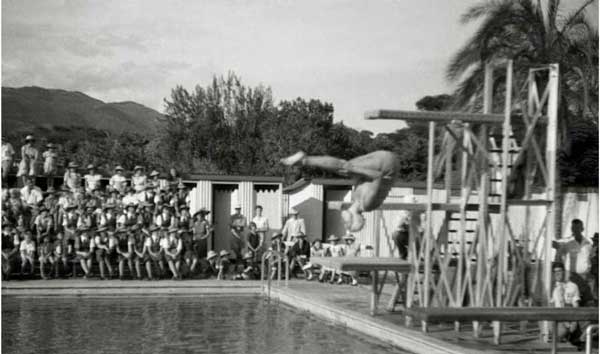
Ann Ross (USA) - diving at Umtali in 1954
The author - Rob McLean.
